Ben's Publications
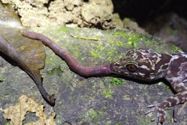
Cyrtodacyluskingsadai. Diet. Herpetological Review 53: 678-679.
2023 -Kane, D., Tapley, B., T.E.M. McCormack and L.T. Nguyen
We report the first record of a Cyrtodacylus gecko feeding on an annelid worm
Cyrtodacylus-kingsadai-Diet-Herpetological-R.pdf
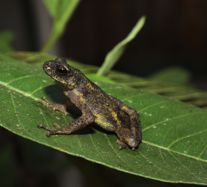
A new species of Bufoides Pillai and Yazdani 1973 (Amphibia: Bufonidae) from Mizoram (India) and the delimitation of the distribution range of Bufoidesmeghalayanus (Yazdani & Chanda 1971) to the Khasi hills, Meghalaya (India). Biodiversitas, 24: 4617-4627
2023 -Naveen, R.S., Tapley, B., Chandramouli, S.R., Jervis, P.A., Babu, S., Meetei, A.B. and P.V. Karunakaran
The Oriental toad genus Bufoides currently comprises two species: Bufoidesmeghalayanus and B. kempi. Populations of Bufoides from Mizoram were previously considered to be conspecific with Bufoidesmeghalayanus, although it has been hypothesized that these populations could represent an undescribed species. An uncorrected p-distance at the 16S rDNA gene between the Mizoram population and each of the two congeneric species was 2.74-3.0% and 3.5% for B. meghalayanus and B. kempi respectively. We describe the population from Dampa Tiger Reserve, Mizoram, as new based on molecular data from two specimens and morphological data from two adult males and one adult female. We confirm that B. meghalayanus is endemic to the Khasi Hills in Meghalaya and it does not occur in Mizoram. The new species from Mizoram differs from congeneric species by differences in interdigital webbing, coloration, skin tuberculation and the presence of ovoid, tuberculated and depressed parotoid glands. Like other Bufoides species, it is a microhabitat specialist and utilizes streamside rock crevices as refugia, which might make it vulnerable to changes in habitat. The new species is currently only known to occur in Dampa Tiger Reserve and it is probably range-restricted and likely meets the International Union for Conservation of Nature’s criteria for being assessed as Critically Endangered.
A-new-species-of-Bufoides-Pillai-and-Yazdani-1973.pdf
https://smujo.id/biodiv
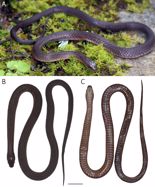
A new species of the genus Rhabdophis Fitzinger, 1843 (Squamata: Colubridae) from the Hoang Lien range, northwest Vietnam. Zootaxa 5343:101-125
2023 -Kane, D., Tapley, B., La, T.V. & L.T. Nguyen
We describe a new species of the Natricinae genus RhabdophisFitzinger, 1843 from the Hoang Lien range, northwest Vietnam. The new species is distinct from all congeneric species on the grounds of morphometric and molecular data. The new species is most similar to Rhabdophisleonardi in terms of morphology but can be distinguished from it based on differences in maxillary tooth count, scalation, and genetic data. A sequence on GenBank from a Rhabdophis specimen collected in Honghe, Yunnan, China was identical to the species we describe, and it is likely that the new species is not restricted to Vietnam. As a priority, future work should focus on determining the distribution of this species, as well as understanding population and life history traits such as reproductive rate.
https://mapress.com/zt/article/view/zootaxa.5343.2.1
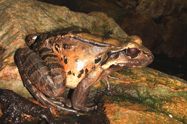
Activity budgets, responses to disturbance and novel behaviours in captive mountain chicken frogs (Leptodactylusfallax). Herpetological Journal. 33: 43-54.
2023 -Mannings, E., Tapley, B. & C.J. Michaels
Mountain chicken frogs Leptodactylusfallax are assessed as Critically Endangered on the IUCN Red List due to threats including chytridiomycosis and habitat loss. Ex-situ populations underpin species survival, but captive management is hampered by incomplete species knowledge, including its behavioural biology. In sixteen adult frogs, we investigated enclosure usage, nocturnal activity budgets, and behavioural responses to varying levels of husbandry-related disturbance through instantaneous scan sampling of camera trap footage over forty-two consecutive nights. Enclosure usage was quantified through the application of modified Spread of Participation Indices (mSPI). We present the first detailed activity budgets published for this species and found that broad activity patterns of captive animals corresponded well with their wild conspecifics; taking refuge during the day and emerging at dusk into exposed areas of the enclosure. Some behaviours, especially hunting and bathing, were partially phased throughout the nocturnal period. Enclosure use was not even, with disproportionately large amounts of time spent using nest boxes and deep leaf litter, even at night, and the converse in thin leaf litter and elevated perches. Principal Components Analysis (PCA) identified a bold-shy behavioural grouping (movement and resting opposed to refuge behaviours) that was consistent across husbandry-related disturbance conditions. Randomisation analyses showed that disturbance significantly affected multiple measured behaviour, especially feeding, social interactions and vocalisation; the impact was associated with the degree of disturbance. Novel behaviours were also documented, which are thought to be related to courtship. Our data provide insights into the behaviour of mountain chicken frogs and highlight potential trade-offs between enclosure maintenance, veterinary intervention, and animal welfare.
Activity-budgets-responses-to-disturbance-and-nov.pdf
https://www.zsl.org/what-we-do/projects/mountain-chicken-frog-conservation

Genetic diversity of the Critically Endangered Big-headed Turtle (Platysternonmegacephalum) based on wild and traded samples: implications for conservation. Diversity. 15: 958.
2023 -Ngo, H.T., McCormack, T.E., Ha, V.L., Tapley, B., Nguyen, T.T., Le, M.H., Le, D.T., Nguyen, T.T., Trinh, H.L.T., Nguyen, T.Q. & T. Ziegler
Overexploitation has driven catastrophic declines in most turtle species in Asia. Many turtles are seized annually by law enforcement officers; unfortunately, seized turtles often lack associated information on their provenance. There is also taxonomic confusion regarding the clear delineation of turtle species and subspecies in Asia. This lack of provenance data and taxonomic uncertainty is problematic as it may preclude release, make appropriate release sites hard to select, or result in genetic pollution when animals are released. In this study, we amassed and analyzed the largest number of genetic samples of the critically endangered big-headed turtle (Platysternonmegacephalum) to date. Our phylogenetic and network results based on nearly 500 sequences of a mitochondrial ND4 fragment corroborate the earlier hypothesis that only two of the three currently recognized subspecies have strong molecular support and that there is greater genetic structuring within one subspecies than has been previously reported. The vast majority of P.megacephalum confiscated from the trade in Vietnam belong to Subclade 3 of P. m. peguense, and this subclade is the most broadly distributed taxon of the big-headed turtle in Vietnam based on samples with known localities. Nonetheless, for the other two subclades, all their samples originate from the trade and could not be assigned to any geographic provenance because of the lack of wild-caught samples. In addition, our results reveal two trade centers of the species include Quang Ninh Province on the border between China and Vietnam and Kon Tum Province in the Central Highlands. However, smaller animal seizures occur across the range of the species in Vietnam. While the data presented here have facilitated the selection of appropriate release sites for confiscated P. megacephalum, the significant costs of genetic screening and the shortage of samples from wild animals with good localities hinder the rewilding efforts, especially for conservation practitioners working in a country where conservation activities are not well funded and research on poorly studied species is still limited. Nevertheless, we urge that wildlife translocations include robust pre-translocation genetic screening to ensure that all individual animals are reintroduced at appropriate sites.
Genetic-diversity-of-the-Critically-Endangered-Big.pdf
https://biaza.org.uk/projects/detail/developing-viable-release-strategies-for-highly-threatened-turtles-seized-from-the-illegal-wildlife-trade-in-vietnam
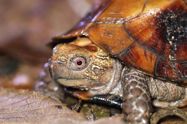
New locality record of Endangered Cuoramouhotii (Gray 1862) from Doimara Reserve Forest, Arunachal Pradesh, Northeast India. Reptiles and Amphibians 30, e18262.
2023 -Teron, G., Tapley, B., Sharma, A.R., Paul, A., Thungon, L.T. & O.P. Tripathi
This article explains the New locality record of endangered Cuoramouhotii (Gray 1862) from Doimara Reserve Forest, Arunachal Pradesh, Northeast India.
New-locality-record-of-Endangered-Cuora-mouhoti.pdf
https://www.edgeofexistence.org/fellow/genius-teron/
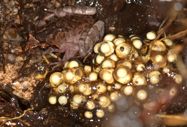
Notes on the oviposition sites of Botsford’s leaf-litter frog (Leptobrachellabotsfordi) and a significant range extension for the species
2023 -Nguyen, L.T., Rowley, J.J.L., La, T.V. and B. Tapley
Botsford's leaf litter frog (Leptobrachellabotsfordi) is listed as Critically Endangered. The species is threatened by ongoing habitat degradation and pollution, most of which is the result of infrastructural developments associated with tourism. We surveyed suitable habitat within the Hoang Lien Range, to better understand the distribution and natural history of L. botsfordi. We detected this species on Mount Nam Kang Ho which is 23.4 km southeast of the closest reported location of the species on Mount Fansipan, expanding the known Extent of Occurrence for the species from 36 km2 to 105.2 km2. As a result, It is likely that L. botsfordi qualifies as being reassessed as Endangered in accordance with the IUCN Red List of Threatened Species categories and criteria B1ab(iii). We also provide the first descriptions of the oviposition sites, egg size and potential nest guarding in L. botsfordi and call for strengthened habitat protection throughout the range of this species.
Notes-on-the-oviposition-sites-of-Botsfords-leaf.pdf
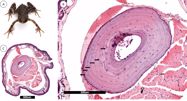
Preliminary data on size and age of Oreolalaxsterlingae (Nuguyen et al., 2013). Herpetology Notes, 16: 643-650.
2023 -Tapley, B., Rowley, J.J.L., Portway, C., Michaels, C.J., Nguyen, L.T. & G.M. Shea.
We followed a standard skeletochronology protocol to assess the age of 17 Oreolalaxsterlingae, an Endangered frog from Viet Nam, through the count of lines of arrested growth (LAGs). We report the maximum recorded size for Oreolalaxsterlingae, age and potential reprtoductive lifespan.
Preliminary-data-on-size-and-age-of-Oreolalax-s.pdf
https://www.biotaxa.org/hn/article/view/82162
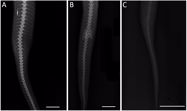
A novel approach to sexing Lachesisstenophrys (Serpentes: Viperidae) using radiography. Herpetological Review 53: 54-57.
2022 -Kane, D., Tapley, B., Guthrie, A., Sparrow, S., Tahas, S.A. and C.J. Michaels
We demonstrate that radiography is a novel approach to sexing Lachesisstenophrys
A-novel-approach-to-sexing-Lachesis-stenophrys.pdf

Amphibians and conservation breeding programmes: how do we determine who should be on the ark? Biodiversity and Conservation
2022 -Bradfield, K., Tapley, B. and K. Johnson
Threatened species identified as priorities for ex situ conservation action are not necessarily the best candidates for conservation breeding programmes (CBPs). To facilitate good decision-making regarding which species to establish CBPs for, species suitability should be critically assessed by both an overarching body or expert group that prioritises all threatened species in a country or region for conservation action, and individual institutions. Once a species has been designated as a priority for conservation action and a CBP has been identified as potentially of value (Stage 1 of a comprehensive assessment process), a more thorough assessment of the species’ suitability for such a programme should be undertaken (Stage 2). Individual institutions, instead of simply addressing their capacity to establish a programme in general, should also take a greater role in robust decision making by critically assessing their suitability for a particular species (Stage 3). The Amphibian Ark’s existing Conservation Needs Assessment and Program Implementation Tool serve as Stage 1 and partial Stage 3, respectively, for threatened amphibian species. We have developed Stage 2 (Species Suitability for a CBP Assessment; expected to be available online in 2023) and revised the Program Implementation Tool to take all major relevant considerations into account (available online). This comprehensive process ensures that well-informed, consistent decisions are made regarding whether or not to establish a CBP for a particular species, thereby directing limited resources to programmes with a higher likelihood of success. Given this, potential to modify this process for use with other taxa should be explored
https://link.springer.com/article/10.1007/s10531-022-02524-4
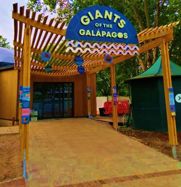
An Improvement in Enclosure Design Can Positively Impact Welfare, Reduce Aggressiveness and Stabilise Hierarchy in Captive Galapagos Giant Tortoises. Journal of Zoological and Botanical Gardens , 3, 499–512.
2022 -Fieschi-Méric, L., Ellis, C., Servini, F., Tapley, B. and C.J. Michaels
The interest in the welfare of zoo animals, from both the public and the scientific community, has long been biased towards mammals. However, growing evidence of the complex behavioural repertoires of less charismatic animals, such as reptiles, reveals the necessity to better comply with their welfare needs in captivity. Here, we present the effects of an enclosure change towards a more natural habitat in captive Galapagos tortoises (Chelonoidis spp.) held at ZSL London Zoo. Using behavioural observations, we found that the tortoises habituated to their new enclosure in six days. This represents the first quantification of habituation latency to a new enclosure in a reptile model to our knowledge—which is important information to adapt policies governing animal moves. The tortoises expressed time budgets more similar to those of wild individuals after their transition to the new enclosure. Interestingly, the hierarchy between the individuals was inverted and more stable after this change in environment. The tortoises interacted less often, which led to a decrease in the frequency of agonistic encounters. We also found that higher ambient sound volume was associated with increased likelihood of interactions turning into fights. Taken together, our results demonstrate the potential of appropriate enclosure design to improve reptile welfare.
An-Improvement-in-Enclosure-Design-Can-Positively.pdf
https://www.zsl.org/zsl-london-zoo/whats-on/giants-of-the-gal%C3%A1pagos-exhibit
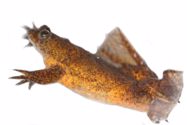
Baseline behavioural data and behavioural correlates of disturbance for the Lake Oku clawed frog (Xenopuslongipes). Journal of Zoological and Botanical Gardens 3:184-197.
2022 -Dias, J.E., Ellis, C., Smith, T.E., Hosie, C.A., Tapley, B. and C.J. Michaels
Animal behavior and welfare science can form the basis of zoo animal management. However, even basic behavioral data are lacking for the majority of amphibian species, and species-specific research is required to inform management. Our goal was to develop the first ethogram for the critically endangered frog Xenopuslongipes through observation of a captive population of 24 frogs. The ethogram was applied to produce a diurnal activity budget and to measure the behavioral impact of a routine health check where frogs were restrained. In the activity budget, frogs spent the vast majority of time swimming, resting in small amounts of time devoted to feeding, foraging, breathing, and (in males) amplexus. Using linear mixed models, we found no effect of time of day or sex on baseline behavior, other than for breathing, which had a greater duration in females. Linear mixed models indicated significant effects of the health check on duration of swimming, resting, foraging, feeding, and breathing behaviors for all frogs. This indicates a welfare trade-off associated with veterinary monitoring and highlights the importance of non-invasive monitoring where possible, as well as providing candidates for behavioral monitoring of acute stress. This investigation has provided the first behavioral data for this species which can be applied to future research regarding husbandry and management practices.
Baseline-behavioural-data-and-behavioural-correlat.pdf
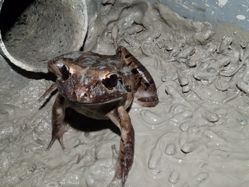
Captive observations of multiple clutching in Leptodactylusfallax Müller, 1926. Herpetological Bulletin 159: 25-28.
2022 -Servini, F., Försäter, K., Tapley, B. and C.J. Michaels
Multiple clutching, with two or three successful clutches raised in a single breeding season, is reported from two females of Leptodactylus fallax in two European zoos. Previously, only single clutches were known to be raised by this species. Multiple clutching is perhaps unexpected in this species due to its resource-heavy parental care behaviour. Potential drivers of multiple clutching, including food resourcing and timing and size of initial clutches, are discussed.
Captive-observations-of-multiple-clutching-in-Lep.pdf

EAZA Best Practice Guidelines for Potomotyphlus and Typhlonectes spp. caecilians – Second edition. European Association of Zoos and Aquariums, Amsterdam, The Netherlands. 52pp.
2022 -Tapley, B., Gower, D.J., Michaels, C.J., Barbon, A., Goetz, M., Lopez, J., Bland, A., Garcia, G., Nelson, N.A., Wilkinson, M. and L. Fieschi-Méric
The information in this Best Practice Guideline has come from a variety of sources including a literature review, the experience of the authors and others in the captive husbandry of Typhlonectes spp. and Potomotyphlus caecilians; a caecilian husbandry questionnaire that involved both zoological collections, aquariums and keepers from the private sector as well as direct observations of the species in the field. In this new version, we incorporate the most recent knowledge gathered from the scientific literature published since the release of the original EAZA BPG in 2019. The physiology of Typhlonectes caecilians has continued to be broadly investigated, with a special emphasis on their reproductive system and hormonal cycles. A new interest in caecilian’ molecular genetics has emerged, with a substantial use of transcriptomics. Advances have been made regarding skin diseases; however, this area needs higher research prioritisation in view of the current context of emerging pathogens that decimate some amphibian populations worldwide. Finally, the knowledge and representation gap among different species within the Typhlonectidae Family is widening: recent scientific publications and ex-situ collections are only associated with two Genera out of the five the Family comprises. Amphibian husbandry is a rapidly evolving field and there are many aspects that require further research. The exact breeding triggers for aquatic caecilians are unknown and further research would be beneficial. Susceptibility to diverse skin diseases needs to be further investigated, to allow the development of appropriate treatments. Lethal dermatitis has recently been reported in captivity, and although the literature suggests that at least some aquatic caecilians are resistant to chytridiomycosis, the epidemiology of other skin diseases requires further research. Key husbandry points 1. The provision of appropriate seasonal temperature regimes. 2. Monitoring and management of water quality. E3. Preventing escape
EAZA-Best-Practice-Guidelines-for-Potomotyphlus.pdf
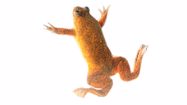
Individual identification of the Lake Oku clawed frog (Xenopuslongipes) using a photographic identification technique. Herpetological Conservation and Biology, 17: 67-75.
2022 -Ævarsson, U., Graves, A., Carter, K.C., Doherty-Bone, T., Kane, D., Servini, F., Tapley, B. and C.J. Michaels
Amphibians are challenging to mark for recapture due to their small size and permeable, sensitive, and often frequently shed skins. Photographic identification and pattern matching techniques are increasingly used as a non-invasive method to identify individual amphibians for the purposes of monitoring individuals over time. The Critically Endangered Lake Oku Clawed Frog (Xenopuslongipes) has distinctively patterned ventral patterns as adults. We used Wild-ID to explore the use of photographic identification for the longitudinal identification of both adult and juvenile X. longipes. We photographed juvenile frogs twice over a 180-d period and adult frogs seven times over 624 d. Juvenile belly patterns underwent marked ontogenetic shifts over the 180-d period and Wild-ID was not able to match photographs of the same individuals over the study period. Markings were more stable in adult frogs and Wild-ID was successful in matching photographs of individual adult frogs over 180 d but became less effective at distinguishing between individuals at 624 d (i.e., Wild-ID similarity scores halved and false rejection rates increased substantially). We detected no false acceptances. Our results provide evidence to guide management of this species in captivity and in the field and demonstrate the importance of considering life-stage linked ontogenetic changes when validating a photographic identification method for amphibians.
Individual-identification-of-the-Lake-Oku-clawed-f.pdf

Microbiome function predicts amphibian chytridiomycosis disease dynamics. Microbiome 10:44.
2022 -Bates, K., Sommer, U., Jopkins, K.P., Shelton, J.M.G., Wierzbicki, C., Sergeant, C., Tapley, B., Michaels, C.J., Schemeller, D.S., Loyau, A., Bosch, J., Viant, M.R., Harrison, X.A., Garner, T.W.J. and M.C. Fisher
Background The fungal pathogen Batrachochytriumdendrobatidis ( Bd ) threatens amphibian biodiversity and ecosystem stability worldwide. Amphibian skin microbial community structure has been linked to the clinical outcome of Bd infections, yet its overall functional importance is poorly understood. Methods Microbiome taxonomic and functional profiles were assessed using high-throughput bacterial 16S rRNA and fungal ITS2 gene sequencing, bacterial shotgun metagenomics and skin mucosal metabolomics. We sampled 56 wild midwife toads ( Alytesobstetricans) from montane populations exhibiting Bd epizootic or enzootic disease dynamics. In addition, to assess whether disease-specific microbiome profiles were linked to microbe-mediated protection or Bd -induced perturbation, we performed a laboratory Bd challenge experiment whereby 40 young adult A. obstetricans were exposed to Bd or a control sham infection. We measured temporal changes in the microbiome as well as functional profiles of Bd -exposed and control animals at peak infection. Results Microbiome community structure and function differed in wild populations based on infection history and in experimental control versus Bd- exposed animals. Bd exposure in the laboratory resulted in dynamic changes in microbiome community structure and functional differences, with infection clearance in all but one infected animal. Sphingobacterium , Stenotrophomonas and an unclassified Commamonadaceae were associated with wild epizootic dynamics and also had reduced abundance in laboratory Bd -exposed animals that cleared infection, indicating a negative association with Bd resistance. This was further supported by microbe-metabolite integration which identified functionally relevant taxa driving disease outcome, of which Sphingobacterium and Bd were most influential in wild epizootic dynamics. The strong correlation between microbial taxonomic community composition and skin metabolome in the laboratory and field is inconsistent with microbial functional redundancy, indicating that differences in microbial taxonomy drive functional variation. Shotgun metagenomic analyses support these findings, with similar disease-associated patterns in beta diversity. Analysis of differentially abundant bacterial genes and pathways indicated that bacterial environmental sensing and Bd resource competition are likely to be important in driving infection outcomes. Conclusions Bd infection drives altered microbiome taxonomic and functional profiles across laboratory and field environments. Our application of multi-omics analyses in experimental and field settings robustly predicts Bd disease dynamics and identifies novel candidate biomarkers of infection.
Microbiome-function-predicts-amphibian-chytridiomy.pdf
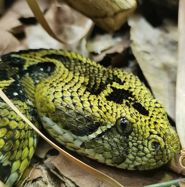
Reproduction of the Ethiopian Mountain Adder, Bitisparviocula Böhme, 1976 (Reptilia: Viperidae), at ZSL London Zoo. Herpetology Notes 15: 423-429
2022 -Kane, D., Tapley, B., Carter, K. and C.J. Michaels
We report on the captive husbandry and reproduction of Bitisparviocula at ZSL London Zoo.
Reproduction-of-the-Ethiopian-Mountain-Adder-Bit.pdf
https://www.zsl.org/blogs/zsl-london-zoo/adder-ing-few-more-snakes-to-zsl-london-zoos-reptile-house%C2%A0

Sexually dimorphic growth and maturity in captive mountain chicken frogs Leptodactylusfallax The Herpetological Bulletin 161: 12–15.
2022 -Michaels, C.J., Carter, K.C., Servini, F. and B. Tapley
Sexual dimorphism is commonly encountered in amphibians. Its presence and its ontogeny in a given species has implications for ecology, conservation and captive husbandry. We monitored changes in length and mass of captive mountain chicken frogs Leptodactylusfallax. Initially, sexes were no different in snout-vent length or mass, but by about 17 months after metamorphosis females became significantly larger and heavier than males. Diverging growth trajectories between male and female frogs appeared to coincide with the development of secondary sexual characters in males, indicating sexual maturity, while female frogs did not produce nests until the following breeding season, suggesting later reproductive maturity. The absence of similar dimorphism in other large leptodactylids suggests that its presence in L. fallax may be linked to its unique and energy-intense reproductive strategy, which involves extended maternal provisioning of their young.
Sexually-dimorphic-growth-and-maturity-in-captive.pdf
https://www.mountainchicken.org/

The advertisement call of the Indochinese Brown Bullfrog, Kaloulaindochinensis Chan, Blackburn, Murphy, Stuart, Emmett, Ho, And Brown, 2013 (Anura: Microhylidae) from Gia Lai Province, Vietnam. Management of Forest Resources and Environment 14:21-27
2022 -Nguyen, L.T., Dung, T.T.T. and B. Tapley
Call descriptions may facilitate studies on behavioural ecology and support taxonomists in their efforts to delimit species. The Indochinese Brown Bullfrog (Kaloulaindochinensis) was described in 2013 and occurs in evergreen forest in Indochina. Whilst the tadpole of the species was recently described, little else is known about the biology and ecology of the species including the call characters. In this paper, we describe the male advertisement calls of the Indochinese Brown Bullfrog, Kaloulaindochinensis from evergreen forest in Gia Lai province, in the Central Highlands of Vietnam for the first time. This species has a slow and low-pitched call that is similar to the sounds of a trumpet to the human ear. The call description of Kaloulaindochinensis is based on recordings from two males. This species has a single call type consisting of a single note per call with a dominant frequency of 0.34 – 0.43 kHz (calls recorded at an air temperature of 20.5°C. The call duration ranged from 194 – 250 milliseconds and the average intercall interval ranged from 481 – 1627 milliseconds. The male advertisement calls of Kaloulaindochinensis is compared with the male advertisement calls for the six congeneric species with published male advertisement call descriptions
The-advertisement-call-of-the-Indochinese-Brown-Bu.pdf
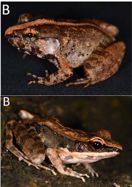
The first records of Limnonecteskohchangae (Smith, 1922) and Sylviranamortenseni (Boulenger, 1903) from Phu Quoc Island, Southern Vietnam 14: 33-39. Management of Forest Resources and Environment
2022 -Nguyen, L.T., Lam, N.Q.,, Le, M.V., Hoang, H.V., McCormack, T.E.M. and B. Tapley
We provide the first detailed records of Limnonecteskohchangae (Smith, 1922) and Sylviranamortenseni (Boulenger, 1903) for Phu Quoc island, Phu Quoc National Park, Kien Giang province, Southern Vietnam. These records are supported by morphology and molecular data. Sylviranamortenseni was associated with large streams between 23-102 m asl. This species has an adult snout-vent length of 46.0-80.9 mm in 3 adult males and 47.7-69.2 mm in 3 adult females. Males have large humeral glands and well developed nuptial pads; a lack of oblique, triangular or teardrop-shaped marking posterior to the tympanum; a dark stripe beneath the dorsolateral fold which lacks a strong demarcation between the dark upper surfaces of the flank and the lighter lower surface; and distinct dark marbling on the posterior surfaces of the thighs. Limnonecteskohchangae was associated with stream headwaters and small streams between 34-201 m asl. Individuals from Phu Quoc Island had an adult snout-vent length ranging from 34.3-41.8 mm in 9 males and 33.3-38.2 mm in 2 females. Dorsum with distinctly elongated tubercles and arranged in rows; a bicoloured tympanum with heavily pigmented upper half; dark spots present on flanks; and a broad band on shank with maximum shank band width > 50% horizontal diameter of eye. This report increases the number of amphibians known to occur on Phu Quoc Island from 14 to 16 species.
The-first-records-of-Limnonectes-kohchangae-S.pdf
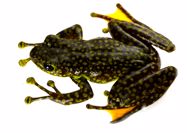
Amolopscaelumnoctis Rao & Wilkinson, 2007, a Junior Synonym of A. splendissimus Orlov & Ho, 2007 (Amphibia: Anura: Ranidae). Zootaxa 5057: 181–200.
2021 -Zhang, Y., Rowley, J.J.L., Liu, X., Nguyen, T.T., Nguyen, H.Q., Tapley, B., Nguyen, L.T., Yang, Y., Cutajar, T., Zhang, Y., Yuan, Z.
Amolopssplendissimus Orlov and Ho, 2007 and A. caelumnoctis Rao and Wilkinson, 2007 were described almost simultaneously from either side of the China-Vietnam border. The two species share a strong morphological resemblance, and their taxonomic distinctiveness has been questioned, yet no one has confirmed the taxonomic relationship and status between the two taxa. To resolve this taxonomic issue, we collected additional topotypic and near-topotypic specimens of A. splendissimus and A. caelumnoctis from both China (A. caelumnoctis: Wenshan County, Yunnan Province; type locality Luchun County, Yunnan Province), and Vietnam (A. splendissimus: Tam Duong District, Lai Chau Province; type locality Mount Ky Quan San, Bat Xat, Lao Cai Province). Molecular analysis based on a 16S rRNA fragment revealed minimal genetic divergences between the two taxa (0.0%–0.4% uncorrected p-distance), and both species are closely related to A. viridimaculatus (2.1%–2.3%) and A. medogensis (3.5%–3.7%). Morphological comparisons between the newly collected specimens and the original descriptions of both species further support the lack of distinctiveness of the two species, hence, we conclude that A. caelumnoctis is a junior synonym of A. splendissimus.
Amolops-caelumnoctis-Rao--Wilkinson-2007-a.pdf
https://www.mapress.com/zt/article/view/zootaxa.5057.2.2
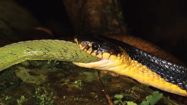
Bungarusfasciatus (Banded Krait) and Trimeresuruscardamomensis (Cardamom Mountains Green Pitviper). Diet and Predation. Herpetological Review 52: 659-660
2021 -Kane, D., Nguyen, L.T., Lam, N.Q., Le, M.V. and B. Tapley
Bungarus-fasciatus-Banded-Krait-and-Trimere.pdf
https://ssarherps.org/publications/herpetological-review/
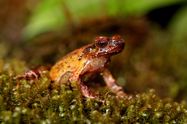
A new potentially Endangered species of Megophrys (Amphibia: Megophryidae) from Mount Ky Quan San, north-west Vietnam. Journal of Natural History 54: 39-40
2021 -Tapley, B., Cutajar, T., Nguyen, L.T., Nguyen, C.T., Harding, L., Portway, C., Luong, H.V. and J.J.L. Rowley.
The genus Megophrys is known to harbour morphological cryptic species diversity. During field work on Vietnam’s third highest peak, Mount Ky Quan San, north-west Vietnam, we collected specimens of a new species of Megophrys at two locations more than 2000 m above sea level (asl). Phylogenetic analyses using mitochondrial markers place the new species within the subgenus Panophrys, a primarily Chinese radiation within the genus Megophrys. We describe the species based on an all-male type series and distinguish it from all other Megophrys species from mainland Southeast Asia, north of the Isthmus of Kra and nearby provinces of China (Yunnan, Guangxi and Guizhou) based on morphological, molecular and bioacoustic data. The new species is inferred to form a clade along with M.hoanglienensis and M.fansipanensis; it is syntopic with the former but has a non-overlapping range with the latter. Uncorrected p distances for the 16S rDNA and CO1 genes between the new species and closest relatives exceed values observed between other closely related species in the Panophrys subgenus. The new species is most similar to M.fansipanensis in terms of morphology, and several call parameters also overlap with this species; however, these two species call at different times of year. This is the fourth likely range restricted and Endangered Megophrys species described from the Hoang Lien Range since 2017, and this discovery further highlights the significance of the Hoang Lien Range for Vietnam’s amphibian diversity.
A-new-potentially-Endangered-species-of-Megophrys.pdf
https://www.zsl.org/blogs/conservation/international-expedition-discovers-new-species-of-frog-from-vietnam-0#:~:text=We%20gave%20this%20frog%20the,frog%20described%20by%20our%20team.
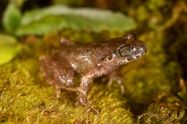
A new species of Leptobrachella (Anura, Megophryidae) from Mount Pu Ta Leng, northwest Vietnam. Zootaxa 5016: 301-332.
2021 -Nguyen, L.T., Tapley, B., Nguyen, C.T., Luong, H.V. and J.J.L. Rowley
The Hoang Lien Range in northwest Vietnam is known to harbour five species of Leptobrachella, a specious genus of terrestrial frogs. We collected specimens of Leptobrachella from Mount Pu Ta Leng on the second highest peak in the Hoang Lien Range and use morphological and molecular data to show that this population represents a previously undescribed species which we name Leptobrachellagraminicola sp. nov. after the abundance of calling males on sedge-like plants. This new species is closely related to L. bourreti but the new species is distinguished from L. bourreti and other congeneric species by a combination of the following characters: (1) a body size range of 23.1–24.6 mm in six adult males and 28.6–32.9 mm in five adult females; (2) skin on dorsum smooth, with many tubercles and lacking dermal ridges; (3) toes with rudimentary webbing and broad lateral fringes; (4) belly white with brown spots; (5) throat dark brown with light grey-brown flecks and spots; (6) a row of large white spots on the outer edge of the tarsus extending from the heel to the inner metatarsal tubercle, sometimes forming a long white stripe; and (7) a bicoloured iris. The new, high-elevation species is likely to be range-restricted and threatened by habitat loss and the activities of tourists.
A-new-species-of-Leptobrachella-Anura-Megophry.pdf
https://frogsoffansipan.org/
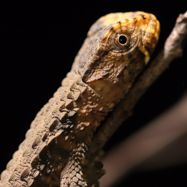
Age-Dependent Enclosure Use in Juvenile Chinese Crocodile Lizards, Shinisauruscrocodiluruscrocodilurus. Journal of Zoological and Botanical Gardens 2: 406-415.
2021 -Carter, K.C., Hicks, J.J., Kane, D., Tapley, B. and C.J. Michaels.
This study compared the resource use of juvenile zoo-living Chinese crocodile lizards, Shinisauruscrocodiluruscrocodilurus across three observation windows, spanning nine months, accounting for time of day and lizard age, and under consistent environmental conditions. Lizards showed a significant difference in proportionate resource use, quantified using a modified spread of participation indices between the second and final sampling period, such that with increasing age, resources were more equally utilised. The time of day did not have a significant effect on resource use. Lizards in this study significantly increased their use of water bodies and branches outside the bask zone and decreased their use of the land areas within the bask zones over time. Resource use data suggests the importance of providing enclosures which cater to ontogenetic shifts in captive individuals or within mixed age groupings.
AgeDependent-Enclosure-Use-in-Juvenile-Chinese-Cr.pdf
http://www.edgeofexistence.org/species/chinese-crocodile-lizard/
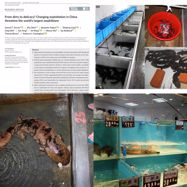
From dirty to delicacy? Changing exploitation in China threatens the world's largest amphibians. People and Nature
2021 -Turvey, S., Chen, S., Tapley, B., Liang, Z., Wei, G., Yang, J., Wang, J., Wu, Mi., Redbond, J., Brown, T. and A.A. Cunningham
1. Determining the dynamics and sustainability of human interactions with threatened species is essential to inform evidence-based conservation, but data can be challenging to collect across large areas and multiple user groups. 2. Chinese giant salamanders Andrias spp. are critically depleted across China. Wild populations were exploited during the 20th century, and more recently to support a large-scale farming industry. However, robust data remain largely unavailable on the timing of population declines in relation to changing human pressures, on primary drivers of exploitation, or on the effectiveness of conservation legislation. 3. We conducted a series of large-scale interview surveys across the range of giant salamanders in China, targeting potential rural and urban user groups, and stakeholders involved with giant salamander exploitation and policy management (comprising 2,932 rural households, 66 salamander farms, 115 county government officials and 835 urban consumers). 4. Giant salamander populations were probably declining from at least the 1980s due to exploitation for food, and negative cultural values associated with these animals have not prevented rural consumption. There has been a major escalation in exploitation following the establishment of a large-scale giant salamander farming industry in the 2000s. Our results demonstrate wide-scale and largely unregulated illegal hunting to stock farms at a country-wide scale in order to support demand by urban consumers for high-prestige rare meat. We estimate there were at least 42,000 wild-caught breeding adult giant salamanders and 164,000 wild-caught subadults in farms across China at the time of our survey. 5. Salamander farming probably poses unsustainable pressure on giant salamander populations. Existing legislation has clearly proved ineffective at preventing the stocking of farms with wild-caught animals, and our findings highlight an important gap in the effectiveness of China's conservation protection for some of its highest-priority threatened species. Tackling this problem will likely require multiple coordinated approaches, including enforcement of legislation, increased penalties for removing giant salamanders from the wild, permanent identification of captive-bred giant salamanders, and consumer-focused interventions to reduce urban demand.
From-dirty-to-delicacy-Changing-exploitation-in-C.pdf
https://besjournals.onlinelibrary.wiley.com/doi/full/10.1002/pan3.10185
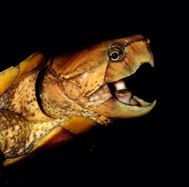
Hunting and trade of big-headed turtles (Platysternonmegacephalum Gray 1831) in two protected areas in northern Vietnam. Herpetology Notes 14: 1077-1085
2021 -Hoang, H., McCormack, T.E.M., Lo, H. and B. Tapley
The big-headed Turtle (Platysternonmegacephalum) is an evolutionary distinct and globally Endangered freshwater turtle species. The primary threat to the species is illegal hunting and trade. However, very little is known about hunting, trade and the conservation status of the species in Vietnam. Interviews with 31 professional P.megacephalum hunters, traders, and agriculturalists around Pu Hu Nature Reserve and Pu Mat National Park, northern Vietnam, revealed that the illegal hunting and trade of this species began in the area over 20 years ago, overlapping with the peak of the Asian Turtle Crisis. Respondents reported that the main hunting season occurs from March to September, and that the traditional bamboo basket trap is considered the most efficient hunting method. The volume of P.megacephalum being hunted and traded has experienced a dramatic decline since the early 2000s, this has been associated with an increased economic value of the species in these illegal markets in which a single kilogram of the species is worth more than the average local monthly income. Despite all respondents acknowledging they were aware of the protected status of freshwater turtles, a lack of sufficient enforcement of protective legislation was evident. The high economic value and ease of hunting this species in its linear stream habitats means urgent improvements to enforcement will be critical to save the remaining populations in both surveyed protected areas.
Hunting-and-trade-of-bigheaded-turtles-Platyste.pdf
https://asianturtleprogram.org/
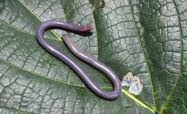
Investigating the effect of disturbance on prey consumption in captive Congo caecilians Herpelesqualostoma. Journal of Zoological and Botanical Gardens 2: 705-715
2021 -Carter, K.C., Fieschi-Méric, L., Servini, F., Wilkinson, M., Gower, D.J., Tapley, B. and C.J. Michaels
Maintaining Gymnophiona in captivity provides opportunities to study the behaviour and life-history of this poorly known Order, and to investigate and provide species appropriate welfare guidelines, which are currently lacking. This study focuses on the terrestrial caecilian Herpelesqualostoma to investigate its sensitivity to disturbances associated with routine husbandry needed for monitoring and maintaining adequate wellbeing in captivity. Fossorial caecilians gradually pollute their environment in captivity with waste products, and substrate must be replaced at intervals; doing so disturbs the animals directly and via destruction of burrow networks. As inappetence is frequently associated with stress in amphibians, the percentage consumption of offered food types, river shrimp (Palaemonvarians) and brown crickets (Gryllusassimilis), was measured as an indicator of putative stress following three routine substrate changes up to 297 days post-substrate change. Mean daily variation in substrate temperatures were also recorded in order to account for environmental influences on food consumption, along with nitrogenous waste in tank substrate prior to a substrate change and fresh top soil in order to understand the trade-off between dealing with waste accumulation and disturbing animals. We found a significant negative effect of substrate disturbance on food intake, but no significant effect of prey type. Variations in daily soil temperatures did not have a significant effect on food intake, but mean substrate temperature did. Additionally, substrate nitrogenous waste testing indicated little difference between fresh and tank substrate. In conclusion, this study provides a basis from which to develop further welfare assessment for this and other rarely kept and rarely observed terrestrial caecilian species.
Investigating-the-effect-of-disturbance-on-prey-co.pdf

Nesting frogs - the breeding biology of Indirana cf. tysoni in the Western Ghats, India. Herpetological Bulletin 155: 2-7
2021 -Mudke, M. and B. Tapley
Frogs of the genus Indirana are endemic to India. Previous research on these frogs has focussed on taxonomy and systematics but their behaviour remains largely understudied. Here we report the breeding behaviour of Indirana cf. tysoni, including nest building, male to male combat, inguinal amplexus, egg clutch guarding, tadpoles and polymorphism. We also analyse advertisement calls and present a comparative analysis with previously published data. Lastly, we discuss the need to study these breeding behaviours in-depth in order to help frame appropriate conservation plans.
Nesting-frogs--the-breeding-biology-of-Indirana-c.pdf
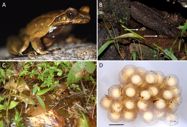
Oviposition sites of the Hoang Lien Horned Frog, Megophryshoanglienensis (Tapley et al., 2018). Herpetology Notes, 14: 937-939
2021 -Tapley, B., Nguyen, L.T., Nguyen, C.T., Hoang, G.T. and T. Cutajar.
We describe the eggs and oviposition sites of the Hoang Lien horned frog (Megophryshoanglienensis), a newly described and poorly known frog that is endemic to the Hoang Lien Range in northwest Vietnam.
Oviposition-sites-of-the-Hoang-Lien-Horned-Frog-M.pdf
https://frogsoffansipan.org/

Predators of the Purple Frog Nasikabatrachussahyadrensis Biju and Bossuyt, 2003. Herpetology Notes, 14:247-249
2021 -Das, S., Easa, P.S., Divakar, N., Thomas, A. and B. Tapley
Nasikabatrachussahyadrensis is an evolutionarily distinct and globally endangered species. Adult frogs are fossorial and they emerge to breed for a brief period during pre-monsoon showers where male frogs call from underground burrows. The brief period of surface activity and underground calling likely reduces mortality from predators. We document the predators of N. sahyadrensis which include brown fish owls, checkered keelbacks and fishing spiders. Our observations demonstrate that N. sahyadrensis may be exposed to high predation pressure during the breeding season and that some predators may adjust their foraging activities so that they are present when N. sahyadrensis briefly emerge.
Predators-of-the-Purple-Frog-Nasikabatrachus-sa.pdf
http://www.edgeofexistence.org/species/purple-frog/
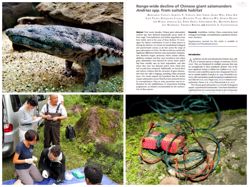
Range-wide decline of Chinese giant salamanders Andrias spp. from suitable habitat. Oryx 00:1-9
2021 -Tapley, B., Turvey, S.T., Chen, S., Wei, G., Xie, F., Yang, J., Liang, Z., Tian, H., Wu, M., Okada, S., Wang, J., Lü, J., Zhou, F., Xu, J., Haipeng, Z., Redbond, J., Brown, T. and A.A. Cunningham
Over recent decades, Chinese giant salamanders Andrias spp. have declined dramatically across much of their range. Overexploitation and habitat degradation have been widely cited as the cause of these declines. To investigate the relative contribution of each of these factors in driving the declines, we carried out standardized ecological and questionnaire surveys at 98 sites across the range of giant salamanders in China. We did not find any statistically significant differences between water parameters (temperature, dissolved oxygen, ammonia, nitrite, nitrate, salinity, alkalinity, hardness and flow rate) recorded at sites where giant salamanders were detected by survey teams and/or had been recently seen by local respondents, and sites where they were not detected and/or from which they had recently been extirpated. Additionally, we found direct and indirect evidence that the extraction of giant salamanders from the wild is ongoing, including within protected areas. Our results support the hypothesis that the decline of giant salamanders across China has been primarily driven by overexploitation. Data on water parameters may be informative for the establishment of conservation breeding programmes, an initiative recommended for the conservation of these species.
Rangewide-decline-of-Chinese-giant-salamanders-A.pdf
https://www.oryxthejournal.org/blog/what-is-driving-the-decline-of-the-largest-amphibians/

Reproduction of Lachesisstenophrys (Central American Bushmaster) at ZSL London Zoo. Herpetological Review 52: 564-566
2021 -Kane, D., Tapley, B., Servini, C., Aevarsson, U. & C.J. Michaels
The captive breeding of the Central American Bushmaster at ZSL London Zoo is described in detail
Reproduction-of-Lachesis-stenophrys-Central-A.pdf
https://www.zsl.org/blogs/zsl-london-zoo/question-how-do-you-weigh-a-baby-snake-answer-very-carefully
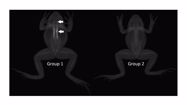
The effects of two calcium supplementation regimens on the fitness and health traits of juvenile mountain chicken frogs (Leptodactylusfallax). Herpetological Journal, 31:18-26.
2021 -Michaels, C.J., Servini, F., Strike, T., Guthrie, A., Tapley, B., Jayson, S., Ferguson, A. and J. Newton-Youens.
The mountain chicken frog (Leptodactylusfallax) is among the 42 % of amphibians threatened with extinction and is dependent upon ex situ populations to recover in the wild. Amphibian captive husbandry is not fully understood and empirical data are required to optimise protocols for each species in captivity. Calcium metabolism and homeostasis are areas of importance in captive husbandry research and have been identified as a challenge in maintaining ex situ populations of L. fallax. We trialled two frequencies (twice and seven times weekly) of calcium supplementation via dusting of feeder insects in two groups of L. fallax juveniles and measured growth and health effects through morphometrics, radiography, ultrasonography and blood and faecal analysis over 167 days, followed by a further 230 days of monitoring on an intermediate diet informed by the initial dataset. We showed that supplementation treatment did not affect growth or health status as measured through blood analysis, radiography and ultrasonography. More frequent supplementation resulted in significantly more radiopaque endolymphatic sacs and broader skulls. Frogs fed more calcium excreted twice as much calcium in their faeces. The intermediate diet resulted in previously lower supplementation frogs approximating the higher supplementation frogs in morphometrics and calcium stores. Comparison with radiographic data from wild frogs showed that both treatments may still have had narrower skulls than wild animals, but mismatching age class may limit this comparison. Our data may be used to inform dietary supplementation of captive L. fallax as well as other amphibians.
The-effects-of-two-calcium-supplementation-regimen.pdf

Impacts of UVB provision on serum vitamin D3, pigmentation, growth rates and total body mineral content in Mallorcan midwife toad larvae (Alytesmuletensis). Journal of Zoo and Aquarium Research 8: 37-44.
2020 -Whatley, C., Tapley, B., Chang, Y.M.R., Newton-Youens, J., Mckendry, D. and C.J. Michaels.
Our understanding of captive husbandry for amphibians is rapidly improving as empirical knowledge in this area grows. Early evidence indicates that UVB radiation is an important aspect of captive husbandry for at least some species, and may be critical in combating nutritional metabolic bone disease and other environmentally linked diseases. However, the limited evidence in this field is restricted to post-metamorphic anurans, and impacts of UVB provision on larvae are even less well known. We measured the effects of ecologically appropriate levels of UVB exposure on growth rates, pigmentation acquisition, serum vitamin levels in the blood plasma, and whole-body mineral content in the Mallorcan midwife toad (Alytesmuletensis). There were no significant effects of UVB exposure on any parameters measured. We were therefore unable to provide clear evidence that UVB irradiation can be used to synthesise vitamin D3 in the skin. Our data suggest that when A.muletensis larvae have access to a diet containing vitamin D3 and under husbandry conditions currently recognised as best practice, UVB irradiation is not required to maintain this species successfully. These results do not indicate that UVB provision is unimportant for amphibian larvae in general, however. Further research is needed to elucidate how tadpoles interact with UVB radiation in nature and to examine how UVB radiation is provided in captivity, and to test for effects using a wider variety of species from a range of different habitats.
Impacts-of-UVB-provision-on-serum-vitamin-D3-pig.pdf

A description of the tadpole of Megophrys "Brachytarsophrys" intermedia (Smith, 1921) Zootaxa 4845 (1): 026–034
2020 -Tapley, B, Nguyen, L.T. and M.V. Le
We present a description of the tadpole of M.intermedia based on four specimens collected at night from a small, slow moving stream with a water temperature of 21.5 ºC in evergreen secondary forest in Song Hinh Protected Forest, Song Hinh District, Phu Yen Province on the eastern slopes of the Langbian Plateau in southern Vietnam. We tentatively suggest that the presence of this white longitudinal stripe could be considered diagnostic of the subgenus Brachytarsophrys. The site where the tadpoles were collected in this study is the lowest published elevation record for the species; 640 m lower than the lowest elevation reported in the IUCN Red List assessment. The Current Extent of Occurrence of M.intermedia is estimated to be 156752 km2 but this is likely to be an underestimate given that the species occurs at much lower elevations than previously reported.
A-description-of-the-tadpole-of-Megophrys-Brachyt.pdf
https://www.zsl.org/science/news/hadnt-the-froggiest
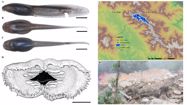
A description of the tadpole of the Critically Endangered Botsford’s leaf-litter frog (Leptobrachellabotsfordi) with comments on the distribution and conservation status of the species. Zootaxa 4860: 293-300.
2020 -Nguyen, L.T., Tapley. B., Cutajar, T., Nguyen, C.T., Portway, C., Harding, L., Luong, H.V. and J.J.L. Rowley
We describe the tadpole of the Botsford’s leaf-litter frog Leptobrachellabotsfordi, a species endemic to Mount Fansipan in northwest Vietnam, for the first time. Tadpoles of this species were found in steep, fast-flowing streams at elevations between 2500–2600 m asl. We also report a previously unknown locality for this species on Mount Fansipan, which increases the species’ known Extent of Occurrence from 8 km2 to 36 km2. Our findings will inform subsequent conservation initiatives for this poorly known and highly threatened species.
A-description-of-the-tadpole-of-the-Critically-End.pdf
https://asianturtleprogram.org/2020-10-decribed-tadpole-leptobrachella-botsfordi/
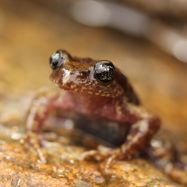
A point endemic no more; a range extension for Oreolalaxsterlingae (Nguyen et al., 2013) in Bat Xat District, Lao Cai Province, northern Vietnam. Herpetology Notes 13:497-500
2020 -Tapley, B., Nguyen, L.T., Portway, C., Cutajar, T., Nguyen, C.T., Luong, H.V., Kane, D., Harding, L. and J.J.L. Rowley
Sterling’s toothed toad, (Oreolalaxsterlingae), is the only member of the genus known from Vietnam. The species is thought to be endemic to Mount Fansipan, Lai Cao Province in northern Vietnam at elevations exceeding 2700 m a.s.l. O.sterlingae is one of just two Critically Endangered amphibians currently known from Vietnam and has an “Extent of Occurrence” (EOO) of just 8 km2. One of the recommended conservation actions for the species is to determine its distribution. We surveyed other sites on Mount Fansipan and high elevation sites in the Hoang Lien Range and encountered O.sterlingae larvae at relatively low elevation on Mount Pu Ta Leng in Bat Xat Nature Reserve, 20 km northeast of the type locality. This greatly increases both the elevation range of the species (from 2900 m a.s.l to 2345–3108 m a.s.l) and the EOO (from 8 km2 to 639 km2). We suggest that O.sterlingae is reassessed as Endangered in accordance with the IUCN Red List of Threatened Species categories and criteria B1ab(iii).
A-point-endemic-no-more-a-range-extension-for-Or.pdf
https://frogsoffansipan.org/
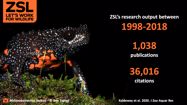
A response to Welden et al. (2020) The contributions of EAZA zoos and aquaria to peer-reviewed scientific research. Journal of Zoo and Aquarium Research 8(2): 133-138
2020 -Koldewey, H., Christie, S., Curnick, D., Hoffmann, M., Masters, N. Pearce-Kelly, P., Rowden, R., Tapley, B. & A. Terry
Welden et al. (2020) summarise and analyse the contribution of EAZA zoos and aquariums to peer-reviewed scientific research, analysing publications generated from EAZA members. As an organisation founded in 1826 that represents the first scientific zoo in the world, we are supportive of publications that highlight this important and often overlooked role of the zoo and aquarium community. However, the paper notes that ‘An outlier, the Zoological Society of London was treated differently, in that only contributions from London Zoo and Whipsnade Zoo were included. The Institute of Zoology which acts as a separate research institution was excluded, as it would not rightfully portray the contribution of zoos or aquaria (D. Field, personal communication)’. As a result, the authors have excluded many staff of the Zoological Society of London (ZSL) who contribute towards the publication of peer-reviewed scientific research from the analysis, meaning the organisation’s full contribution is not well presented.
A-response-to-Welden-et-al-2020-The-contributio.pdf
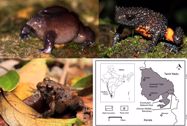
Are local and traditional ecological knowledge suitable tools for informing the conservation of threatened amphibians in biodiversity hotspots? Herpetological Bulletin 153: 3-13
2020 -Kanagavel, A., Parvathy, S., Tapley, B., Nirmal, N., Selvaraj, G., Raghavan, R., Murray, C., Owen, N. and S. Turvey.
Globally, amphibians are declining more rapidly than any other vertebrate group. A general shortage of funding for the support of focused scientific studies led us to investigate local and traditional ecological knowledge as an alternative data source for amphibian conservation. In this context, we undertook a questionnaire-based interview survey with forest-dwelling indigenous and non-indigenous communities across the Anamalai Hills, within the southern Western Ghats of India, to gather ecological knowledge on three cryptic and threatened frog species. Our results suggest that local communities possess ecological knowledge of frogs and that the magnitude of this knowledge is influenced by gender, community type, education, and age. Accuracy of local knowledge was primarily influenced by the morphological distinctiveness of the focal species, but cultural association and utilisation were also important factors especially for the enigmatic purple frog Nasikabatrachussahyadrensis, which has uses in medicine and amulets.
Are-local-and-traditional-ecological-knowledge-sui.pdf
https://www.edgeofexistence.org/blog/introducing-edge-fellow-arun-kanagavel/
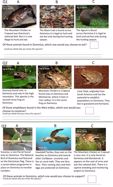
Cultural association and its role in garnering support for conservation: the case of the Mountain Chicken Frog on Dominica. Amphibian and Reptile Conservation. 14:133-144
2020 -Nicholson, D., Kanagavel, A., Barron, J., Durrand, S., Murray, C. and B. Tapley
The cultural significance of a species can play an important role in garnering local support for conservation. In this study, the Critically Endangered Mountain Chicken Frog (Leptodactylusfallax) on Dominica is used as a case study to understand whether a species' cultural association affects local opinion towards its use and conservation. The species chosen is emblematic and was once widely consumed. Picture-choice questions were used to explore the effect of cultural associations with L.fallax on public preference in comparison with other species. The association with L.fallax as a past unofficial national dish garners substantial local support for it relative to other amphibians, but this effect has waned since the species has declined. The influence of L.fallax as a cultural icon could be improved by association as a symbol of national respect, much like the national bird (Amazonaimperialis) which currently benefits from this stature.
Cultural-association-and-its-role-in-garnering-sup.pdf
https://www.mountainchicken.org/
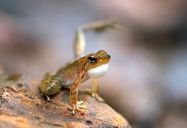
First report on the fossorial tadpole of Micrixalus kottigeharensis (Rao, 1937) Herpetology Notes13: 645-648
2020 -Mudke, M., Aravind, N.A., Gururaja, K.V., Tapley, B., Thunga, P., Das, J., Prince, H. and S. Sreevathsa
The Kottigehar dancing frog, *Micrixalus kottigeharensis* is an evolutionarily distinct and Critically Endangered frog endemic to the central Western Ghats of India. We describe the fossorial tadpole for the first time and provide additional information on reproductive biology.
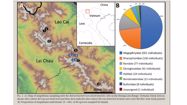
Low Prevalence of Batrachochytriumdendrobatidis Detected in Amphibians from Vietnam’s Highest Mountains. Herpetological Review 51: 726-732.
2020 -Tapley, B., Jervis, P., Nguyen, L.T., Portway, C., Nguyen, C.T., Luong, H.V., Kane, D., Brookes, L., Perkins, M.W., Ghosh, P., Wierzbicki, C., Shelton, J., Fisher, M.C. and J.J.L. Rowley.
This study investigates the presence of Batrachochytriumdendrobatidis (Bd) in the Hoang Lien Range and patterns of Bd infection in space, time, and host species over a five-year sampling period. This study also investigates the presence of Batrachochytriumsalamandrivorans in the Hoang Lien Range.
Low-Prevalence-of-Batrachochytrium-dendrobatidi.pdf
https://www.zsl.org/blogs/science/do-chytrid-fungi-pose-a-threat-to-northern-vietnams-frogs

Postmortem findings in eight species of captive caecilian (Amphibia: Gymnophiona) over a ten-year period Journal of Zoo and Wildlife Medicine 50:879-890
2020 -Flach, E., Feltrer, Y., Gower, D., Jayson, S., Michaels, C.J., Pocknell, A., Rivers, S., Perkins M., Rendle, M.E., Stidworthy M.F., Tapley, B., Wilkinson, M. and N. Masters.
Between July 2007 and June 2017 there were 86 deaths in the populations of eight caecilian species at the Zoological Society of London (ZSL) London Zoo. The mortality rate (deaths per animal-year at risk) ranged from 0.03 in the Congo caecilian (Herpelesqualostoma) to 0.85 in Kaup's caecilian (*Potomotyphlus kaupii*). Among the 73 individuals examined post mortem, no cause of death or primary diagnosis could be established in 35 cases, but of the others the most common cause of death was dermatitis (22 cases). When all significant pathological findings were considered, skin lesions of varying types were again the commonest (56 cases), particularly among the aquatic species: Typhlonectescompressicauda (18 out of 21 cases), T.natans (8/10) and P.kaupii (12/14). Other common findings were poor gut-fill (35 cases), kidney and gastrointestinal lesions (10 cases each), generalized congestion (8 cases) and poor body condition (6 cases). This review adds to the growing body of knowledge regarding the presentations and causes of disease in captive caecilians.
Postmortem-findings-in-eight-species-of-captive-ca.pdf

Substrate preference in the fossorial caecilian Microcaecilaunicolor (Amphibia: Gymnophiona, Siphonopidae). Herpetological Bulletin 152:18-20
2020 -Whatley, C., Tapley, B., Michaels, C.J., Gower, D.J. and M. Wilkinson
Caecilians epitomise the complexities of maintaining poorly known amphibian taxa in captivity. Empirical data on even the most basic husbandry parameters are lacking for most species of caecilian, including the substrate used to maintain them. We used a simple choice chamber to compare two commonly used substrate types. Microcaecilaunciolor were housed in individual choice chambers. On one side of the chamber we used Megazorb as a substrate and on the other we added moistened topsoil. Our results show that M.unicolor has a statistically significant preference for Megazorb as a diurnal resting site.
Substrate-preference-in-the-fossorial-caecilian-M.pdf

The advertisement call of Megophrysjingdongensis (Fei and Ye, 1983) and a new record from Lai Chau Province, Northeast Vietnam. Herpetology Notes 13: 139-143.
2020 -Cutajar, T., Rowley, J.J.L., Nguyen, L.T., Nguyen, C.T., Portway, C., Harding, L., Luong, H.V and B. Tapley.
We encountered M.jingdongensis at night during field work in the Hoang Lien Range in June 2012, June 2016 and September 2017. Megophrysjingdongensis was observed at two sites in disturbed broad leaf forest between 1685–2153 m a.s.l. in Lao Cai Province and two sites in disturbed broad leaf forest Lai Chau Province between 1887–1923 m a.s.l. (see Table 1). This is the first record of M.jingdongensis in Lai Chau Province, and this collection site is 372 km southeast of the approximate type locality. This new locality is not a significant range extension, it has been collected previously from adjoining Sa Pa District in Lao Cai Province although precise collection site details were not reported.
The-advertisement-call-of-Megophrys-jingdongensis.pdf
https://australianmuseum.net.au/blog/amri-news/finding_a_frogs_voice/

The southernmost distribution on the Rhinoceros snake Gonyosomaboulengeri (Mocquard, 1897) (Reptile, Squamata, Colubridae) in Vietnam. Check List 16: 337-342.
2020 -Nguyen, L.T., Kane, D., Le, M.V., Nguyen, T.T., Hoang, H.V., McCormack, T.E., Tapley, B and S.N. Nguyen, S. N.
We report the southernmost record of the Rhinoceros Snake, Gonyosomaboulengeri (Mocquard, 1897) from Phu Yen Province, southern Vietnam, based on a single specimen collected from forest in the Ca Range. This record extends the distribution of G.boulengeri approximately 600 km south of previous records in Vietnam (Quang Binh Province, central Vietnam). A detailed description of a hemipenis is also provided for the first time.
The-southernmost-distribution-on-the-Rhinoceros-sn.pdf

The tadpoles of five Megophrys Horned frogs (Amphibia: Megophryidae) from the Hoang Lien Range, Vietnam. Zootaxa 4845 (1): 035–052
2020 -Tapley, B, Nguyen, L.T., Cutajar, T., Nguyen, C.T., Portway, C., Luong, H.V. and J.J.L. Rowley
Frogs in the genus Megophrys are an Asian radiation of stream-breeding frogs. The tadpoles of many Megophrys species are undescribed; those that are described are often dubiously allocated to species by association with post metamorphic specimens at collection sites and without supportive molecular data. We provide detailed descriptions of the larvae of five species of Megophrys from the Hoang Lien Range in northwest Vietnam: Megophrysfansipanensis, M.gigantica, M.hoanglienensis, M.jingdongensis and M.maosonensis. Tadpoles from different subgenera differ from each other via a combination of patternation in life, oral disc shape and tail morphology but given the small sample size, and limited number of species it is unlikely that these differences can be applied more widely to delineate subgenera. Morphological differences between tadpoles from species within the subgenus Panophrys were insufficient to clearly delineate all species. The ability to identify tadpoles is likely to advance our understanding of the frog fauna in mainland southeast Asia.
The-tadpoles-of-five-Megophrys-Horned-frogs-Amp.pdf
https://www.bbc.co.uk/news/science-environment-54006016
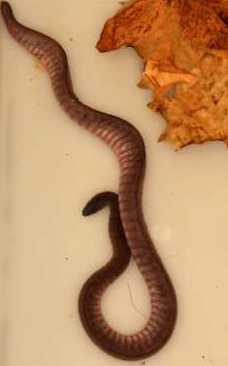
EAZA Best Practice Guidelines for typhlonectid caecilians – First edition. European Association of Zoos and Aquariums, Amsterdam, The Netherlands. 47pp.
2019 -Tapley, B., Gower, D.J., Michaels, C.J., Barbon, A., Goetz, M., Lopez, J., Bland, A., Garcia, G., Nelson, N.A. and M. Wilkinson.
The information in this Best Practice Guideline has come from a variety of sources including a literature review, the experience of the authors and others in the captive husbandry of typhlonectid caecilians; a caecilian husbandry questionnaire that involved both zoological collections, aquariums and keepers from the private sector as well as direct observations of the species in the field. Amphibian husbandry is a rapidly evolving field and there are many aspects that require further research. The exact breeding triggers for typhlonectid caecilians are unknown and further research would be beneficial. Typhlonectid caecilians have also tested positive for Batrachochytriumdendrobatidis (Bd), the causative agent of the disease chytridiomycosis. Treatment of Bd infections in caecilians has had mixed success. Further research into the epidemiology of the disease in caecilians as well as treatment protocols also require further research. Key husbandry points 1. The provision of appropriate seasonal temperature regimes. 2. Monitoring and management of water quality. 3. Preventing escape
EAZA-Best-Practice-Guidelines-for-typhlonectid-ca.pdf
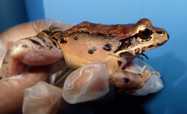
Best Practice Guidelines for the Mountain Chicken (Leptodactylusfallax). European Association of Zoos and Aquaria, Amsterdam, The Netherlands.
2019 -Jameson, T. J. M., Tapley, B., Barbon, A. R., Goetz, M., Harding, L., Lopez, J., Upton, K. and G. Gerardo.
Key husbandry points 1. The supply of environmental UV-B and dietary supplementation with calcium are important in ensuring healthy growth and development of Leptodactylusfallax and in preventing metabolic bone disease (MBD). 2. Facilities should be designed to mimic wild conditions as closely as possible. Such designs should include a diverse range of resting areas and refugia, a diverse range of thermal environments, and opportunities for free range foraging for live prey. Such facilities should also facilitate easy maintenance by staff. 3. Much of the ex-situ Leptodactylusfallax population must be maintained in quarantine under biosecure conditions. This requires specially designed and maintained facilities. 4. Close replication of the nutritional profile of the wild diet in captivity is potentially of great importance for the health of captive Leptodactylusfallax. This is currently limited by the difficulty of maintaining sufficiently large captive colonies of prey species that match the nutritional profile of wild prey. 5. Biosecurity and barrier management are an important part of the management of the captive population of Leptodactylusfallax. In the European region there are two exsitu metapopulations of L.fallax, the biosecure population (managed for future conservation translocation/ supplementation) and the non-biosecure population managed for conservation education and conservation research. At the very basic level, all populations of L.fallax should be managed so that they do not pose a risk to native amphibian species both in the ex-situ locality and upon future reintroduction to the wild. 6. Bespoke techniques for handling and identification of individual Leptodactylusfallax have been developed and are outlined in these guidelines. 7. Bespoke veterinary techniques have been developed for Leptodactylusfallax for carrying out health checks and for treatment of specific conditions and are outlined in these guidelines.
Best-Practice-Guidelines-for-the-Mountain-Chicken.pdf
https://www.mountainchicken.org/
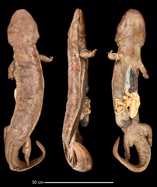
Historical museum collections clarify the evolutionary history of cryptic species radiation in the world's largest amphibians. Ecology and Evolution, 9: 10070-10084.
2019 -Turvey, S.T., Marr, M.M., Barnes, I., Brace, S., Tapley, B., Murphy, R.W., Zhao, E. and A.A. Cunningham.
Abstract Inaccurate taxonomic assessment of threatened populations can hinder conservation prioritization and management, with human‐mediated population movements obscuring biogeographic patterns and confounding reconstructions of evolutionary history. Giant salamanders were formerly distributed widely across China, and are interpreted as a single species, Andriasdavidianus. Previous phylogenetic studies have identified distinct Chinese giant salamander lineages but were unable to associate these consistently with different landscapes, probably because population structure has been modified by human‐mediated translocations for recent commercial farming. We investigated the evolutionary history and relationships of allopatric Chinese giant salamander populations with Next‐Generation Sequencing methods, using historical museum specimens and late 20th‐century samples, and retrieved partial or near‐complete mitogenomes for 17 individuals. Samples from populations unlikely to have been affected by translocations form three clades from separate regions of China, spatially congruent with isolation by either major river drainages or mountain ranges. Pliocene–Pleistocene divergences for these clades are consistent with topographic modification of southern China associated with uplift of the Qinghai‐Tibet Plateau. General Mixed Yule Coalescent model analysis indicates that these clades represent separate species: Andriasdavidianus (Blanchard, 1871) (northern Yangtze/Sichuan), Andriassligoi (Boulenger, 1924) (Pearl/Nanling), and an undescribed species (Huangshan). Andriassligoi is possibly the world's largest amphibian. Inclusion of additional reportedly wild samples from areas of known giant salamander exploitation and movement leads to increasing loss of biogeographic signal. Wild Chinese giant salamander populations are now critically depleted or extirpated, and conservation actions should be updated to recognize the existence of multiple species.
Historical-museum-collections-clarify-the-evolutio.pdf
https://www.nationalgeographic.com/animals/2019/09/giant-salamander-new-species-worlds-largest-amphibian/
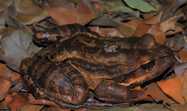
Reservoir frogs: seasonality of Batrachochytriumdendrobatidis infection in robber frogs in Dominica and Montserrat. PeerJ, 7: p.e7021.
2019 -Hudson, M.A., Griffiths, R.A., Martin, L., Fenton, C., Adams, S.L., Blackman, A., Sulton, M., Perkins, M.W., Lopez, J., Garcia, G., Tapley, B., Young, R.P. and A.A. Cunningham.
Emerging infectious diseases are an increasingly important threat to wildlife conservation, with amphibian chytridiomycosis, caused by Batrachochytriumdendrobatidis, the disease most commonly associated with species declines and extinctions. However, some amphibians can be infected with B.dendrobatidis in the absence of disease and can act as reservoirs of the pathogen. We surveyed robber frogs (Eleutherodactylus * spp.), potential B. dendrobatidis reservoir species, at three sites on Montserrat, 2011-2013, and on Dominica in 2014, to identify seasonal patterns in B.dendrobatidis infection prevalence and load (B.dendrobatidis genomic equivalents). On Montserrat there was significant seasonality in B.dendrobatidis prevalence and B.dendrobatidis load, both of which were correlated with temperature but not rainfall. B.dendrobatidis prevalence reached 35% in the cooler, drier months but was repeatedly undetectable during the warmer, wetter months. Also, B.dendrobatidis prevalence significantly decreased from 53.2% when the pathogen emerged on Montserrat in 2009 to a maximum 34.8% by 2011, after which it remained stable. On Dominica, where B.dendrobatidis emerged seven years prior to Montserrat, the same seasonal pattern was recorded but at lower prevalence, possibly indicating long-term decline. Understanding the dynamics of disease threats such as chytridiomycosis is key to planning conservation measures. For example, reintroductions of chytridiomycosis-threatened species could be timed to coincide with periods of low B.dendrobatidis infection risk, increasing potential for reintroduction success.
Reservoir-frogs-seasonality-of-Batrachochytrium-d.pdf
https://www.mountainchicken.org/
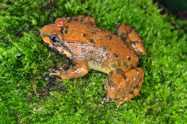
The first record of Limnonectesnguyenorum McLeod, Kurlbaum & Hoang (Amphibia: Anura: Dicroglossidae) from Lao Cai Province, Northwest Vietnam. Proceedings of the 4th National Scientific Conference on Amphibians and Reptiles in Vietnam. 135-139.
2019 -Nguyen, L.T., Tapley, B., Cutajar, T., Nguyen, C.T., Portway, C., Harding, L., Luong, H.V. and J.J.L. Rowley.
We report Nguyen's fanged frog (Limnonectesnguyenorum) for the first time from Lao Cai Province in northwest Vietnam. Specimens were collected in June 2018 from Mount Fansipan in Hoang Lien National Park and identified based on morphological and molecular data. Our record extends the known elevation range of the species (up to 1.300m vs. 1.030m in previous records), brings the number of Limnonectes species recorded from Lao Cai Province to three, and is the first record of Limnonectesnguyenorum from Mount Fansipan.
The-first-record-of-Limnonectes-nguyenorum-McLeod.pdf
https://frogsoffansipan.org/

The use of visible implant elastomer to permanently identify caecilians (Amphibia: Gymnophiona). Herpetological Bulletin 150: 18-22.
2019 -Tapley, B., Michaels, C.J., Gower, D.J. and M. Wilkinson.
Identifying individual animals is important for studying populations and for the optimal management of individual animals in captivity. In the absence of natural markings that discriminate individuals, such identification may require animals to be marked by researchers. Amphibians are challenging subjects to mark due to their small size and sensitive, permeable and frequently shed skin. Visible Implant Elastomer (VIE) has been widely used to mark amphibians, but no long-term study has validated this technique in caecilian amphibians. We anaesthetised and attempted to VIE mark seven Herpelesqualostoma and one Microcaeciliaunicolor held at ZSL London Zoo. No specimens suffered ill effects of anaesthesia or VIE injection, but mean persistence of marks was 191 days in H.squalostoma suggesting that this marking technique is not suitable for identifying individuals of this species in the long-term. We were unable to inject VIE into the M.unicolor and/or the elastomer was not visible through the darkly pigmented skin. Further research is required to develop methods for long-term marking of a diversity of caecilians.
The-use-of-visible-implant-elastomer-to-permanentl.pdf
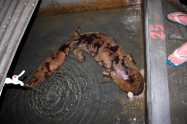
A giant challenge. Zooaquaria, 102: 26–27.
2018 -Tapley, B., Chen, S., Turvey, S.T. and A.A. Cunningham.
A-giant-challenge-Zooaquaria-102-2627.pdf
https://chinesegiantsalamanders.org/
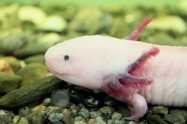
Batrachochytriumdendrobatidis infection and treatment in the salamanders Ambystomaandersoni, A.dumerilii and A.mexicanum. Herpetological Journal, 28: 87-92.
2018 -Michaels, C.J., Rendle, M., Gibault, C., Lopez, J., Garcia, G., Perkins, M.W., Cameron, S. and B. Tapley.
In order to better understand the impacts of treatment of infection with Batrachochytriumdendrobatidis (Bd) and Batrachochytriumsalamandrivorans (Bsal) it is important to document host species, the effect of infection and response to treatment protocols. Here we report asymptomatic Bd infection detected through duplex qPCR screening of three Mexican ambystomatid salamanders; Ambystomaandersoni, Ambystomadumerilii and Ambystomamexicanum at three zoo collections, and A.andersoni and A.mexicanum in a private collection. Bsal was tested for but not detected. We also report the effectiveness and side effects of five treatment protocols in these species. Using the antifungal agent itraconazole, A.dumerilii were cleared of infection without side-effects using the granulated preparation (Sporanox). Morbidity and mortality occurred when A.dumerilii and A.andersoni were treated using a liquid oral preparation of the itraconazole (Itrafungol); infection was successfully cleared in surviving specimens of the latter species. Ambystomamexicanum was successfully cleared without any side-effects using Itrafungol. Mortality and morbidity were likely caused by toxic effects of some component on the liquid preparation of itraconazole, but aspects of water quality and husbandry cannot be ruled out.
Batrachochytrium-dendrobatidis-infection-and-treat.pdf
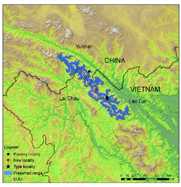
A new locality and elevation extension for Megophrysrubrimera in Bat Xat Nature Reserve, Lao Cai Province, northern Vietnam. Herpetology Notes, 11: 865-868.
2018 -Tapley, B., Cutajar, T., Nguyen, L.T., Nguyen, C.T., Harding, L., Portway, C., Luong, H.V. and J.J.L. Rowley.
Megophrysrubrimera Tapley et al., 2017 was recently described from two localities in northern Vietnam and southern China (Sa Pa District, Lao Cai Province, northern Vietnam, and Jinping County, Yunnan Province, southwest China at elevations of 1400 - 1722 m a.s.l.). The species is only known from a relatively small area of forest, and the Area Of Occupancy (AOO) and Extent Of Occurrence (EOO) were predicted to be 385 km2 and 2298 km2 respectively. Megophrysrubrimera is thought to be forest-dependent, and forest loss within its predicted range is ongoing, likely making the species Endangered in accordance with the IUCN Red List of Threatened Species.
A-new-locality-and-elevation-extension-for-Megophr.pdf
https://frogsoffansipan.org/

Cannibalism in the Critically Endangered Lake Oku Clawed Frog: a possible cause of morbidities and mortalities? Herpetology Notes, 11: 667-669.
2018 -Doherty-Bone, T., Nyingchia, O. and B. Tapley.
An incidence of cannibalism is here reported for the Lake Oku Clawed Frog (Xenopuslongipes). This is a Critically Endangered species endemic to a crater lake in Cameroon, threatened particularly by stochastic events such as fish introduction and has been observed to undergo mass mortalities and morbidities.
Cannibalism-in-the-Critically-Endangered-Lake-Oku.pdf
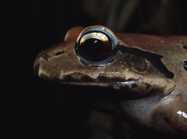
Comparison of the nutritional content of the captive and wild diets of the Critically Endangered mountain chicken frog (Leptodactylusfallax) to improve its captive husbandry. Zoo Biology. 37: 332-346.
2018 -Jayson, S., Ferguson, A., Goetz, M., Routh, A., Tapley, B., Harding, L., Michaels, C.J. & J. Dawson.
It is vital to provide appropriate nutrition to maintain healthy populations in conservation breeding programs. Knowledge of the wild diet of a species can be used to inform captive diet formulation. The nutritional content of the wild diet of the critically endangered mountain chicken frog (Leptodactylusfallax) is unknown, like that of most amphibians. In this study, we analyzed the nutritional content of food items that comprise 91% of the wild diet of L.fallax, by dry weight of food items, and all food items offered to captive L.fallax at ZSL London Zoo and Jersey Zoo. We subsequently compared the nutritional content of the wild diet and captive diet at ZSL London Zoo consumed by L.fallax. To the authors’ knowledge, this is the first study to directly compare the nutritional content of the wild and captive diets of an anuran amphibian. The captive diet at ZSL London Zoo, without dusting of nutritional supplements, was higher in gross energy and crude fat and lower in ash, calcium and calcium:phosphorus ratio than the wild diet. Most of the food items in the captive diets had a high omega‐6:omega‐3 fatty acid ratio and in the wild diet had a low omega‐6:omega‐3 fatty acid ratio. We recommend a combination of modifications to the captive diets to better reflect the nutritional content of the wild diet. Nutritional analysis of captive and wild diets is recommended for other species in conservation breeding programs to improve captive husbandry and ultimately fitness.
https://www.mountainchicken.org/
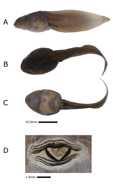
Description and development of the tadpole of Rhacophorusfeae (Anura; Rhacophoridae). Zootaxa, 4504: 138-44.
2018 -Kane, D., Michaels, C.J. and B. Tapley.
The genus Rhacophorus Kuhl & Van Hasselt is currently known to contain 92 species of frogs, distributed across south and south-east Asia. Rhacophorusfeae Boulenger is a large member of this genus and has a seemingly expansive range been recorded from southern Yunnan in China, the Karen hills in Myanmar, northern Thailand, northern Laos and northern Vietnam . It is currently included in the intrageneric R.dennysi group (Dubois 1986) along with R.duboisi Ohler, Marquis, Swan & Grosjean, R.dennysi Blanford, R.dugritei (David), R.minimus Rao, Wilkinson & Liu, R.hungfuensis Liu & Hu, R.dorsoviridis Bourret, R.nigropunctatus Liu, Hu & Yang, and R.smaragdinus (Blyth).
Description-and-development-of-the-tadpole-of-Rhac.pdf
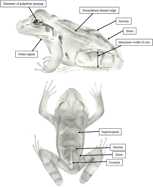
Development of a body condition score for the mountain chicken frog (Leptodactylusfallax). Zoo Biology, 37: 196-205.
2018 -Jayson, S., Harding, L., Michaels, C.J., Tapley, B., Hedley, J., Goetz, M., Barbon, A., Garcia, G., Lopez, J. and E. Flach.
The Critically Endangered mountain chicken frog (Leptodactylusfallax) has undergone drastic population decline due to habitat loss, hunting, invasive species, and chytridiomycosis. In response, several partner institutions initiated a conservation breeding program. It is important to maintain the captive population in good health. Therefore the program partners have recommended establishment of protocols for health examination of the species, including body condition assessment. Visual body condition scoring is a useful means to assess body condition in zoo animals for which regular body weight measurements are impractical or associated with capture‐related stress. In this study, the authors developed a visual body condition score for the mountain chicken frog based on an ordinal categorical scale from 1 to 5 (1 = lowest body condition, 5 = highest body condition) using anatomical features that vary with total body energy reserves. Veterinary staff, animal managers, keepers, researchers, and students subsequently used the body condition score to assign scores to 98 mountain chicken frogs (41 male, 57 female) aged between 8 months and 12 years housed in five zoos in the UK and Jersey between February and March 2016. Body condition scores showed moderate (rho = 0.54; males) to strong (rho = 0.6; females) correlation with the scaled mass index, an objective measure of total energy reserves. The majority of pairwise comparisons between scores showed slight to substantial intra‐observer agreement (93.8%) and slight to almost perfect inter‐observer agreement (97.2%). Cases of poor agreement were likely due to limited observer experience working with the species.
Development-of-a-body-condition-score-for-the-moun.pdf
https://www.mountainchicken.org/
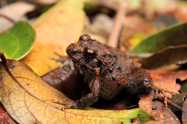
Distribution and habitat associations of the Critically Endangered frog Walkeranaphrynoderma (Anura: Ranixalidae), with an assessment of potential threats, abundance, and morphology. Phyllomedusa, 17: 21-37.
2018 -Kanagavel, A., Parvathy, S., Chundakatil, A.P., Dahanukar, N. and B. Tapley.
Distribution and habitat associations of the Critically Endangered frog Walkeranaphrynoderma (Anura: Ranixalidae), with an assessment of potential threats, abundance, and morphology. Little is known about Walkeranaphrynoderma, a frog endemic to the Anamalai Hills of the Western Ghats of India. Baseline information (i.e., distribution, threats, habitat characteristics, activity patterns, and relative abundance) is provided for this species, with the aim of improving our understanding of the status of the species in the wild. Visual-encounter, transect, and time-activity budget surveys were conducted in and around the Anamalai Hills of the Western Ghats. The frog skin was swabbed to determine the presence/absence of Batrachochytriumdendrobatidis, and habitat and environmental characteristics were recorded at sites where W.phrynoderma was found. These data were compared with those of sites apparently lacking this species that had suitable habitat. Walkeranaphrynoderma is restricted to evergreen forests between 1300 and 1700 m a.s.l. in the Anamalai Tiger Reserve and at Munnar; thus, its range was extended from the state of Tamil Nadu to the adjoining state of Kerala. Pesticide runoff and human disturbance are the most severe threats to the species; B.dendrobatidis was not detected. This nocturnal anuran prefers forest edges and is associated with well-shaded forest floors in cool areas near freshwater streams. Walkeranaphrynoderma is rarely encountered whereas its congener, W.leptodactyla, is more common. The impact of anthropogenic disturbances, especially waste disposal and development of tourism infrastructure, should be evaluated. The land that is owned by the Forest Department peripheral to the protected areas could be designated as eco-sensitive sites to prevent changes in land use that could have an adverse effect on W.phrynoderma.
Distribution-and-habitat-associations-of-the-Criti.pdf

Ferlavirus-related deaths in a collection of viperid snakes. Journal of Zoo and Wildlife Medicine, 49: 9834995.
2018 -Flach, E.J., Dagleish, M.P., Feltrer, Y., Gill, I.S., Marschang, R.E., Masters, N., Orós, J., Pocknell, A., Rendle, M.E., Strike, T. and B. Tapley, B.
Between June and October 2013, 26 snakes of six viperid species kept in two adjoining rooms died (n= 16) or were euthanized on medical (1) or welfare grounds (9). Two were from the main zoo collection, but the other 24 had been imported and quarantined for a minimum of 6 mo. Four of those that died and the single snake euthanized on medical grounds showed minor signs of respiratory disease prior to death, and five were weak, lethargic, and/or poor feeders. Frequent postmortem findings among all snakes were poor body condition (18) and respiratory disease (13). Seventeen cases were examined histologically, and pneumonia, sometimes with air sacculitis and/or tracheitis, was present in 15 individuals. Lung samples from 24 snakes were ferlavirus polymerase chain reaction (PCR) positive, and one of the two snakes for which only liver was available was also positive. The negative liver sample was from a snake that died of sepsis following anesthesia for surgical removal of a spindle cell sarcoma. Correlation with antemortem PCR testing of glottal and cloacal swabs in five cases was poor (sensitivity = 40%). Immunohistochemistry (IHC) for ferlaviruses on the tissues of 13 PCR-positive cases showed positive labeling in 7 only. Tissues samples from 22 ferlavirus PCR-positive snakes were examined for Chlamydia species by PCR, and 9 were positive, although DNA sequencing only confirmed two of three tested as Chlamydiapneumoniae. Immunohistochemistry for Chlamydiapneumoniae of seven cases (two Chlamydiales PCR positive, one of which was sequenced as C.pneumoniae, plus five negative) confirmed the Chlamydia PCR results. These two Chlamydiales PCR and IHC positive snakes were ferlavirus PCR positive, but IHC negative suggesting that, even though a ferlavirus was the predominant cause of the outbreak, in a few cases death may have been due to chlamydiosis with ferlavirus present, but not acting as the primary pathogen.
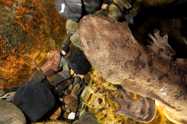
Imminent extinction in the wild of the world’s largest amphibian. Current Biology, 28: R592-R594.
2018 -Turvey, S.T., Chen, S., Tapley, B., Wei, G., Xie, F., Yan, F., Yang, J., Liang, Z., Tian, H., Wu, M., Okada, S., Wang, J., Lü, J., Zhou, F., Papworth, S.K., Redbond, J., Brown, T., Che, J. and A.A. Cunningham
Species with large geographic ranges are considered resilient to global decline. However, human pressures on biodiversity affect increasingly large areas, in particular across Asia, where market forces drive overexploitation of species. Range-wide threat assessments are often costly and thus extrapolated from non-representative local studies. The Chinese giant salamander (Andriasdavidianus), the world's largest amphibian, is thought to occur across much of China, but populations are harvested for farming as luxury food. Between 2013 and 2016, we conducted field surveys and 2,872 interviews in possibly the largest wildlife survey conducted in China. This extensive effort revealed that populations of this once-widespread species are now critically depleted or extirpated across all surveyed areas of their range, and illegal poaching is widespread.
https://chinesegiantsalamanders.org/
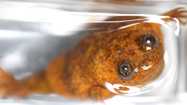
Modulation of foraging strategy is elicited in response to both behaviourally distinct prey items and olfactory cues alone in the aquatic frog Xenopuslongipes (Anura: Pipidae). Herpetological Bulletin, 143: 1-6.
2018 -Michaels, C.J., Das, S. and B. Tapley.
Aquatic predators must forage for prey in a complex three-dimensional environment where the availability of different prey types with different spatial niches may vary. Aquatic predators have evolved a number of ways in which they may respond to this variation, including phenotypic adaptation and behavioural modulation. We investigated whether clawed frogs (Xenopuslongipes) can modulate their foraging behaviour in response to benthic (bloodworms) and pelagic (glassworms) prey species to which they had already been exposed, and whether any response would be elicited by chemosensory prey cues alone. Frogs responded to the presence of prey items by foraging more than in a control treatment (no cues at all) and were able to respond appropriately to prey type, foraging more in the water column for glassworms and on the aquarium floor for bloodworms. This effect was maintained in a second set of trials where frogs were exposed only to the chemosensory cues of the same prey items. These data show that X.longipes can modulate its foraging strategy to match the type of prey available and that this behaviour is at least in part informed by chemosensory cues.
Modulation-of-foraging-strategy-is-elicited-in-res.pdf

Tapley, B., Michaels, C.J., Gower, D. and M. Wilkinson, M.
2018 -Filling in the blanks, the role of caecilians in zoo collections. BIAZA news, 2: 26.
Tapley-B-Michaels-CJ-Gower-D-and-M-Wilki.pdf
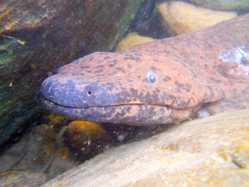
The Chinese giant salamander exemplifies the hidden extinction of cryptic species. Current Biology, 28: R590-R592.
2018 -Yan, F., Lü, J., Zhang, B., Yuan, Z., Zhao, H., Huang, S., Wei, G., Mi, X., Zou, D., Xu, W. Chen, S., Wang, J., Feng, X., Wu, M., XIaou, H., Liang, Z., Jin, J., Wu, S., Xu, C., Tapley, B., Turvey, S.T., Papenfuss, T.J., Cunningham, A.A., Murphey, R.W., Zhang, Y. and J. Che.
Overexploitation, habitat destruction, human-driven climate change and disease spread are resulting in the extinction of innumerable species, with amphibians being hit harder than most other groups. Few species of amphibians are widespread, and those that are often represent complexes of multiple cryptic species. This is especially true for range-restricted salamanders. Here, we used the widespread and critically endangered Chinese giant salamander (Andriasdavidianus) to show how genetically uninformed management efforts can negatively affect species conservation. We find that this salamander consists of at least five species-level lineages. However, the extensive recent translocation of individuals between farms, where the vast majority of extant salamanders now live, has resulted in genetic homogenization. Mitochondrial DNA (mtDNA) haplotypes from northern China now predominate in farms. Unfortunately, hybrid offspring are being released back into the wild under well-intentioned, but misguided, conservation management. Our findings emphasize the necessity of genetic assessments for seemingly well-known, widespread species in conservation initiatives. Species serve as the primary unit for protection and management in conservation actions, so determining the taxonomic status of threatened species is a major concern, especially for amphibians. The level of threat to amphibians may be underestimated, and existing conservation strategies may be inadvertently harmful if conducted without genetic assessment.
The-Chinese-giant-salamander-exemplifies-the-hidde.pdf
https://chinesegiantsalamanders.org/
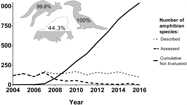
The disparity between species description and conservation assessment: A case study in taxa with high rates of species discovery. Biological Conservation, 220: 209-214.
2018 -Tapley, B., Michaels, C.J., Gumbs, R., Böhm, M., Luedtke, J., Pearce-Kelly, P., Rowley, J.J.L.
The IUCN Red List of Threatened Species (Red List) details the extinction risk of the world's species and presents an important biodiversity indicator for conservation policy. Its continued utility relies on it containing up-to-date information on the extinction risk of species. This requires both regular reassessments and the timely assessment of newly described species. We provide an overview of the status of amphibian Red List assessments to highlight the difficulties of keeping assessments updated for species groups with high rates of species description. Since the publication of the IUCN's Global Amphibian Assessment in 2004, description rates of new species and assessment rates were initially similar; yet while the former has remained consistent, the latter has recently sharply declined. Currently 61.3% of amphibian species are either Not Evaluated or have out-of-date assessments. The situation is particularly problematic in countries with the richest amphibian diversity, which typically have the highest rates of amphibian species discovery and face the greatest threats. Efforts to keep the Red List up-to-date are primarily limited by funding, we estimate that an annual investment of US $170,478-$319,290 is needed to have an up-to-date Red List for amphibians. We propose suggestions to increase assessment rates by improving the availability of data relevant to the process: authors of species descriptions or taxonomic revisions should publish information relevant to Red List assessments. Taxonomic journals should suggest inclusion of such information in their author guidelines. We suggest that contributors with significant input into assessments should be rewarded with co-authorship of published assessments.
The-disparity-between-species-description-and-cons.pdf
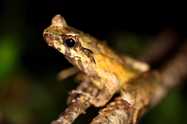
Two new and potentially highly threatened Megophrys Horned frogs (Amphibia: Megophryidae) from Indochina’s highest mountains. Zootaxa, 4508: 301-333.
2018 -Tapley, B., Cutajar, T., Mahony, S., Nguyen, C.T., Dau, V.Q., Luong, A.M., Le, D.T., Nguyen, T.T., Nguyen, T.Q., Portway, C., Van Luong, H. and J.J.L. Rowley.
Megophrys are a group of morphologically conserved, primarily forest-dependent frogs known to harbour cryptic species diversity. In this study, we examined populations of small-sized Megophrys from mid- and high elevation locations in the Hoang Lien Range, northern Vietnam. On the basis of morphological, molecular and bioacoustic data, individuals of these populations differed from all species of Megophrys known from mainland Southeast Asia north of the Isthmus of Kra and from neighbouring provinces in China. Further, the newly collected specimens formed two distinct species-level groups. We herein describe two new species, Megophrysfansipanensis sp. nov. and Megophryshoanglienensis sp. nov. Both new species are range restricted and likely to be highly threatened by habitat degradation. These discoveries highlight the importance of the Hoang Lien Range for Vietnam’s amphibian diversity
https://www.zsl.org/conservation/news/aint-no-mountain-high-enough-two-new-frog-species-found-on-vietnams-highest
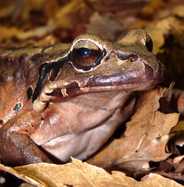
The Mountain Chicken Recovery Programme. Amphibian Ark Newsletter 40: 3–4.
2017 -Dawson, J., Sulton, M., Martin, L., Garcia, G., Harding, L., Nygren, E. and B. Tapley.
The Mountain Chicken Frog (Leptodactylusfallax) is the largest native amphibian species in the Caribbean and one of the world’s largest species of frog. The species is Critically Endangered and underwent catastrophic range-wide population declines of over 85% in less than eighteen months after the emergence of chytrid, the fastest ever decline witnessed in a vertebrate species. In response to these population declines, ex situ safety-net populations were established in 2009 at several institutions in Europe; ZSL London Zoo in the UK, Durrell Wildlife Conservation Trust’s Jersey Zoo in Jersey, Chester Zoo in the UK, and Parken Zoo in Sweden and later, Nordens Ark, also in Sweden. A range-country facility was established on Dominica in the Caribbean and has housed Mountain Chickens since mid-2011 (Tapley et al., 2014). The captive populations in Europe are closely managed by an Endangered Species Programme (EEP). The aim of the EEP is to ensure a genetically viable population of Mountain Chicken Frogs is maintained for future conservation translocations; Dr Gerardo Garcia, Curator of Lower Vertebrates and Invertebrates at Chester Zoo is studbook holder for the Mountain Chicken EEP. Whilst there are small, fragmented Mountain Chicken populations on Dominica, we only know of two individuals surviving on the island of Montserrat in the Caribbean. Currently the immediate future of the species on Montserrat is uncertain with the most realistic hope being through captive breeding and release.

A global problem requires a global multifaceted solution. Animal Conservation, 20: 122-12.
2017 -Tapley, B., Michaels, C.J., Johnson, K., Field, D.
Amphibians are disproportionately threatened and ex situ programmes are often considered the last line of defence against amphibian population and or species extinction. Biega et al. (2017) examined whether zoos and other ex situ partners house amphibian species that are considered priorities for conservation. The authors recommend that zoos continue to increase their holdings of threatened amphibian species; a recommendation that echoes that of Dawson et al. (2015) who also examined zoo holdings of threatened amphibian species. We feel that this recommendation is overly simplistic as there are a number of important considerations other than threat status that should be considered when selecting whether a species is suitable for a conservation breeding programme (CBP). Considerations include species biology, existing husbandry knowledge, ability to obtain enough founding stock to support genetically robust populations, political support and stability in founder countries and exit strategies (Tapley et al., 2015); range-restricted habitat specialists may not always be the most suitable species for CBPs
A-global-problem-requires-a-global-multifaceted-so.pdf
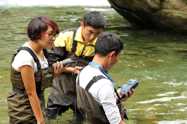
A sustainable future for Chinese giant salamanders: Chinese giant salamander field survey manual. Technical report, Zoological Society of London. Available at: http://www.amphibians.org/
2017 -Tapley, B., Chen, S., Turvey, S.T., Redbond, J., Okada, S. and A.A. Cunningham.
A number of methods are utilised to survey Cryptobranchid salamanders and these methods vary greatly in their efficacy and invasiveness. The Chinese giant salamander (Andriasdavidianus) is the world’s largest amphibian. Historically, this species was found over much of southern and central China in the Pearl, Yellow and Yangtze River drainage basins. Despite its large size and wide distribution relatively little is known about this species and range wide surveys have not been undertaken. In order to understand the distribution and population status of Chinese giant salamanders it is pivotal that the data collected during field surveys is comparable between sites, the use of standardised methods is therefore of the upmost importance. This field manual has been produced to facilitate the adoption of standardised Chinese giant salamander surveys in China that are minimally invasive, logistically feasible and robust. It is our hope that these methods will be used by all researchers working to collect data on the species.
A-sustainable-future-for-Chinese-giant-salamanders.pdf
https://news.mongabay.com/2015/11/chinese-giant-salamander-millions-farmed-nearly-extinct-in-the-wild/

An action plan for the amphibians of the Hoang Lien Range 44pp.
2017 -Tapley, B., Rowley, J.J., Chung, N.T. and LV Hao.
The amphibians of Indochina are both poorly known and highly threatened. Facing amongst the highest deforestation rate on the planet, and over-harvesting pressure, Southeast Asian amphibians are being driven towards an extinction crisis. One of the biggest obstacles facing amphibian conservation in the region is our lack of knowledge of amphibians. As such, it is vital that surveys and taxonomic research along with population monitoring continues so that the true patterns of diversity can be revealed and population declines detected. There is an urgent need to prioritise both species and habitats that require protection. One of the most important areas in the region for amphibian diversity and endemism is the Hoang Lien Range, home to more the 80 species of amphibian, some of which are restricted to very small areas and are the most threatened amphibian species in mainland Southeast Asia. The higher elevations of Hoang Lien National Park are important sites for biodiversity, and are the only known location for mainland Southeast Asia's only confirmed Critically Endangered amphibians, Sterling’s Toothed Toad, Oreolalaxsterlingae and Botsford’s Leaf-litter Frog, Leptolalaxbotsfordi. Both species became known to science recently, being scientifically described in only 2013. The habitat of both species is threatened by human activities, particularly tourism. Fortunately, as the impacts of tourism can be minimised, many of the associated threats facing the species are potentially reversible. Priority actions identified to ensure the long term conservation of amphibians in the Hoang Lien Range are (1) the strict protection of key breeding sites including access restriction so that habitats can recover and pollution of the streams minimised; (2) priority amphibian species receive full and active protection by the Vietnamese government and that amphibians are considered when future developments in these upland areas are designed and implemented; (3) long-term population monitoring of the priority amphibian species; (4) Comprehensive inventories of the amphibian diversity of the Hoang Lien Range so that areas and species in need of conservation attention are identified; (5) the development of a Communication, Education and Public Awareness programme (CEPA) aimed at encouraging behavioural changes that benefit biodiversity. This action plan will involve international collaboration and a long term commitment from all partners and could be used as a model for other taxonomic groups and areas within the region.
https://frogsoffansipan.org/
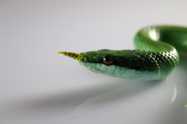
Captive husbandry and breeding of Gonyosomaboulengeri. Herpetological Bulletin, 139: 7–11.
2017 -Kane, D., Gill, I., Harding, L., Capon, J., Franklin, M., Servini, F., Tapley, B. and C. Michaels.
The rhino rat snake Gonyosomaboulengeri is a medium-sized arboreal colubrid snake from southern China and northern Vietnam. Captive specimens maintained at the Zoological Society of London presented little difficulty in husbandry and were found to breed between March and June. A clutch of 9 eggs were laid on the 16 May 2008 and a clutch of 8 eggs were laid on 4 July 2013, following manipulation of the captive environment to reflect natural seasonality for this species. Post-laying incubation temperature was maintained at a constant 28.0 ˚C and lasted 52 days for the 2008 clutch and 57 days for the 2013 clutch. All individuals from the 2013 clutch had sloughed their skin for the first time by 10 days post-hatching, and five of the six fed, subsequent to sloughing, by 20 days post-hatching.
Captive-husbandry-and-breeding-of-Gonyosoma-boulen.pdf
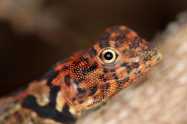
Captive husbandry and breeding of the tree-runner lizard (Plicaplica) at ZSL London Zoo. Herpetological Bulletin, 138: 1-5.
2017 -Harding, L., Tapley, B., Gill, I., Kane, D., Servini, F., Januszczak, I.S., Capon-Doyle, J.S. and Michaels, C.
Tree-runner lizards, Plicaplica are neo-tropical ground lizards, native to South America. ZSL London Zoo has bred this species to the second generation (F2); and the 2.1 founder group has produced six clutches with a mean average of three eggs. The eggs were all removed for incubation, producing 11 viable hatchlings. The first F2 breeding took place in September 2015, and a clutch of two eggs were incubated producing two viable hatchlings. This paper describes the captive husbandry and breeding of Plicaplica at ZSL London Zoo, and serves to make some preliminary comparisons to wild data to suggest further areas of research and improvements for captive husbandry.
Captive-Husbandry-and-Breeding-of-the-Treerunner.pdf

Development of in-country live food production for amphibian conservation: The Mountain Chicken Frog (Leptodactylusfallax) on Dominica, West Indies. Amphibian and Reptile Conservation, 11: 59-68.
2017 -Nicholson, D., Tapley, B., Jayson, S., Dale, J., Harding, L., Spencer, J., Sulton, M., Durand, S. and A.A. Cunningham.
Amphibian populations are in global decline. Conservation breeding programs (CBPs) are a tool used to prevent species extinctions. Ideally, to meet biosecurity, husbandry and other requirements, CBPs should be conducted within the species' geographic range. A particular issue with in-country amphibian CBPs is that of live food supply. In many areas, such as oceanic islands, commonly cultured food species used by zoos throughout the world cannot be used, as escapes are certain to occur and could lead to the introduction of alien, and potentially highly destructive, invasive species. Here, we describe the establishment of live food cultures for the Critically Endangered Mountain Chicken Frog (Leptodactylusfallax) at a conservation breeding facility on the Caribbean island of Dominica. Not all invertebrate species were suitable for long-term culture and several species were rejected by captive L.fallax, making them unsuitable as food items. Despite the CBP being established within a range state, it was not possible to provide a diet of comparable variety to that of wild L.fallax. Our experiences may provide guidance for the establishment of live food culture systems for other conservation breeding programs elsewhere.
Development-of-incountry-live-food-production-for.pdf
https://www.mountainchicken.org/
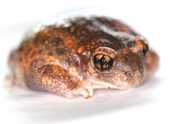
Relating natural climate and phenology to captive husbandry in two midwife toads (Alytesobstetricans and A.cisternasii) from different climatic zones. Amphibian Ark Newsletter, 38: 15-17
2017 -C.J., Fahrbach, M., Harding, L., Bryant, Z., Capon- Doyle, J.S., Grant, S., Gill, I. and B. Tapley, B.
With over 500 amphibian species thought to require urgent ex situ intervention, it is important that husbandry practices are optimised. Unfortunately, many amphibian species have not been maintained in captivity before and initial attempts may be partly or wholly unsuccessful. Amphibians, like all organisms, exhibit adaptations in physiology, ecology, behaviour and phenology to their natural habitat. Moreover, amphibians are typically highly sensitive to their immediate environment and often have highly specific requirements for survival and reproduction. Therefore it has been suggested that, from observations of the wild habitat, inferences can be made about the captive husbandry needs of amphibians. This concept has been further extended to suggest that in the absence of field data on a focal species, observations of a closely-related, or ‘analog’, species may be used as a proxy. Caveats concerning the selection of analog species are frequently overlooked, however, and the importance of understanding similarities and differences between focal and candidate analog species may be forgotten. Despite frequent practical application, there have been few investigations that explore the linked concepts of field data informed captive husbandry and analog species in practice.
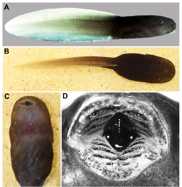
Tadpole of the Critically Endangered Sterling’s Toothed Toad (Oreolalaxsterlingae). Zootaxa, 4272: 579-582.
2017 -Rowley, J.J., Tapley, B., Chung, N.T. and R. Altig.
Sterling’s Toothed Toad, Oreolalaxsterlingae (Nguyen et al. 2013), was described from near the summit of the highest peak in Vietnam, Mount Fansipan, Lao Cai Province. The species is the only member of the genus in Vietnam and is presently known from a single stream system on Mount Fansipan at about 2800 m elevation. The closest congener occurs more than 200 km away in China (Fei et al. 2010), and the relationship of O.sterlingae within the genus is not known. Because of its extremely small range and profound habitat modifications and pollution at the site, O.sterlingae was recently assessed as Critically Endangered (IUCN SSC 2015).
https://frogsoffansipan.org/
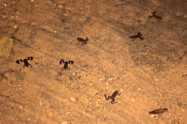
The Importance of Incorporating Field Data into Captive Breeding Programs, and Vice Versa: Breeding the Critically Endangered Lake Oku Frog (Xenopuslongipes) at ZSL London Zoo. Froglog,118: 47-49
2017 -Tapley, B., Michaels, C., Harding, L., Gill, I., Nyingchia, O. and T. Doherty-Bone.
Zoos are in a unique position to undertake research that may underpin conservation efforts. Key areas of research include the development of husbandry techniques, which are frequently subtle, complex and highly specific and elucidation of species biology, which is often difficult, and sometimes impossible, to observe in the field.

The Vietnamese population of Megophryskuatunensis (Amphibia: Megophryidae) represents a new species of Asian horned frog from Vietnam and southern China. Zootaxa, 4344: 465-492.
2017 -Tapley, B., Cutajar, T., Mahony, S., Nguyen, C.T., Dau, V.Q., Nguyen, T.T., Van Luong, H. and J.J Rowley.
The Asian frog genus Megophrys is a diverse group of morphologically conserved, forest-dwelling frogs. The genus harbours highly localised species diversification and new species continue to be described on a regular basis. We examined the taxonomic status of a population of Megophrys frogs from the Hoang Lien Range in northern Vietnam and southern China previously identified as M.kuatunensis (subgenus Panophrys). Preliminary phylogenetic analyses using a fragment of 16S rDNA places the species in question within the Megophrys (subgenus Panophrys) species group, a primarily Chinese radiation within the genus. On the basis of morphological, molecular and bioacoustic data, we conclude that this population does not represent M.kuatunensis, or any known species in the genus. We herein describe this species of Megophrys as new. Known only from Sa Pa District, Lao Cai Province in Vietnam and Jinping County, Yunnan Province in China, the new species is likely to be threatened by ongoing deforestation in the region. We provide an updated species description of M.kuatunensis based on type specimens, and suggest that M.kuatunensis is likely to be restricted to eastern China.
The-Vietnamese-population-of-Megophrys-kuatunensis.pdf
https://frogsoffansipan.org/
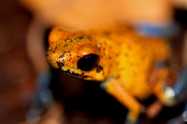
Zoological Society of London: contributions towards advancing the field of herpetology through conservation, research, captive management and education. Herpetological Bulletin, 139: 1-6.
2017 -Tapley, B., Bielby, J., Bohm, M., Brookes, L., Capel, T., Capon-Doyle, J.S., Chen, S., Cliffe, A., Clifforde, L., Couchman, O., Cunningham, A.A., Feltrer, Y., Ferguson, A., Flach, E., Franklin, M., Garner, T.W.J., Gill, I.
Founded in 1826, the Zoological Society of London (ZSL) is a world-renowned centre of excellence for conservation science and applied conservation. ZSL’s mission is to promote and achieve the worldwide conservation of animals and their habitats and this is realised by carrying out field conservation and research in over 50 countries, conducting original scientific research, and through education and awareness at its two zoos, London Zoo and Whipsnade Zoo, inspiring people to take conservation action. ZSL has always had a strong herpetological focus and the emphasis on reptiles and amphibians is perhaps now stronger than ever before with many different aspects of herpetology being advanced through close collaboration between the different departments within ZSL.
Zoological-Society-of-London-contributions-toward.pdf
https://www.zsl.org/

Amphibians and conservation breeding programmes: do all threatened amphibians belong on the Ark? Froglog, 116: 23-27
2016 -Michaels, C., Tapley, B., Bradfield, K. and M. Bungard.
In 2005, the Amphibian Conservation Action Plan (ACAP) was produced by the IUCN/SSC to outline the threats faced by amphibians worldwide and the conservation steps necessary to protect them (1). A key component of this document, and the one that caught the attention of zoos, conservationists and the public globally, was the concept of conservation breeding programs (CBPs) and ark populations. In the face of rapid, enigmatic and catastrophic declines, populations of amphibians could be collected from the wild and held in breeding centers until the coast was clear for reintroductions to take place. The Amphibian Ark was launched to co-ordinate captive programs in zoos, aquaria and academic institutions around the world, and the 2008 Year of the Frog focussed media attention on the ex situ management of threatened amphibians
Amphibians-and-conservation-breeding-programmes-d.pdf
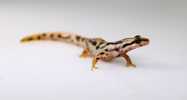
EAZA Amphibian Taxon Advisory Group Best Practice Guidelines for the Sardinian brook salamander Euproctusplatycephalus. Report number: Version 1, European Association of Zoos and Aquaria
2016 -Tapley, B., Michaels, C., Macale, D., Vignoli, L., Harding, L., Bryant, Z., Gill, I. ans S. Funnel.
The information in this Best Practice Guideline has come from a variety of sources including an extensive literature review, the experience of the authors and others in the captive husbandry of Euproctusplatycephalus as well as direct observations of the species in the field. Amphibian husbandry is a rapidly evolving field and there are many aspects that require further research. UV-B provision for captive newts and salamanders is an area which requires further research. A full suite of water parameters is not currently available from the field. It has only been possible to recommend water parameters based on captive husbandry experience and a more evidence based approach utilising parameters from the field should be developed in order to make evidence based husbandry recommendations. Captive diets for both larval and post metamorphic amphibians are likely to differ from diets consumed by larval and post metamorphic amphibians in the field. Replicating the wild diet in captivity will likely be precluded by the limited number of invertebrate species that can be reared on scale required for them to form viable live food colonies. Key husbandry points 1. This species is sensitive to mildew and pathogenic fungus that attack the eggs and larva. Good water quality and well oxygenated aquariums are essential to help prevent this. 2. The provision of appropriate seasonal temperature regimes. 3. Monitoring and management of water quality.
EAZA-Amphibian-Taxon-Advisory-Group-Best-Practice.pdf

Gupta, B.K., Tapley, B., Vasudevan, K. and M. Goetz.
2016 -Ex situ management of amphibians. 10/2015; Assam State Zoo cum Botanical Garden.
Amphibian husbandry is a rapidly developing field and it has become apparent that amphibians have complex and varied husbandry requirements and are not necessarily easy to maintain and breed. Many species have not been maintained in captivity, therefore developing appropriate and optimal husbandry and breeding techniques is crucial to the success of ex situ programmes. Tropical species in particular have proven difficult to establish in captivity, due to high levels of endemism combined with a tendency towards high levels of environmental specificity and limited husbandry experience or field data. Herein we present a number of species specific husbandry guidelines. Whilst some of these guidelines are based on direct experience either with the specific species or a closely related species, others (E.g. Clinotarsus, Indirana, Ramanella and Uperodon) have been compiled based on how we would go about maintaining a species in captivity based on field experience and literature reviews.
Gupta-BK-Tapley-B-Vasudevan-K-and-M-Goet.pdf
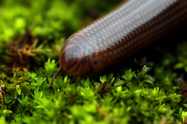
Hot and bothered: using trait-based approaches to assess climate change vulnerability in reptiles. Biological Conservation, 204: 32-41.
2016 -Böhm, M., Cook, D., Ma, H., Davidson, A.D., García, A., Tapley, B., Pearce-Kelly, P. and J. Carr.
One-fifth of the world's reptiles are currently estimated as threatened with extinction, primarily due to the immediate threats of habitat loss and overexploitation. Climate change presents an emerging slow-acting threat. However, few IUCN Red List assessments for reptiles explicitly consider the potential role of climate change as a threat. Thus, climate change vulnerability assessments can complement existing Red List assessments and highlight further, emerging priorities for conservation action.
Hot-and-bothered-using-traitbased-approaches-to.pdf
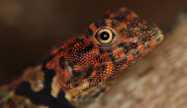
Is behavioural enrichment always a success? Comparing food presentation strategies in an insectivorous lizard (Plicaplica). Applied Animal Behaviour Science, 183: 95-103.
2016 -Januszczak, I.S., Bryant, Z., Tapley, B., Gill, I., Harding, L. and C.J. Michaels.
Staggering food availability through a delivery device is a common way of providing behavioural enrichment as it is usually thought to increase the amount of natural behaviour due to the unpredictability of the food source. Tree-runner lizards (Plicaplica) are a Neotropical, scansorial, insectivorous species. We provided these lizards with an enrichment device that slowly released insect prey and tested its effect on the activity and frequency of a number of behaviours in comparison with a scatter control (where prey items were broadcast in the enclosure; standard food presentation for captive insectivorous lizards) and a non-feeding control. Both types of food increased activity and counts of several behaviours in comparison with the non-feeding control. However, we found the provision of the behavioural enrichment device led to a significantly lower frequency of almost all analysed behaviours in comparison with scatter control trials, mainly in behaviours associated with activity (unsuccessful strikes (= unsuccessful capture of prey) (p = 0.004), locomotion (p = 0.004), alertness (p = 0.004) and the number of times a boundary in the enclosure was crossed ie. activity (p = < 0.001)). The frequencies significantly increased in the enrichment trials (relative to the scatter control) were the number of successful strikes (= successful capture of prey; p = <0.001) and targeting prey (p = <0.001). There was no significant difference in latency to first strike (p = 0.24), duration of hunting activity (p = 0.83) or enclosure use (p>0.05) between scatter and enriched trials. The relative success of the scatter feed in promoting activity and increasing hunting difficulty was likely partly due to the enclosure design, where the complex physical environment contributed to the difficultly in catching the prey. However, when the feeding duration and enclosure use was analysed there was no significant difference between the scatter control and enrichment trails. The results from this study highlight the importance of evaluating enrichment strategies, and the role of complex enclosure design in creating effective enrichment for insectivores, which can contribute to their welfare in captivity.
Is-behavioural-enrichment-always-a-success-Compar.pdf
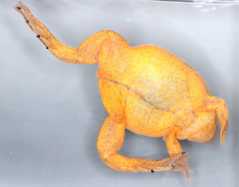
Lake Oku frog - EAZA best practice guidelines. Affiliation: EAZA.
2016 -Tapley, B., Michaels, C., Harding, L., Gill, I., Doherty-Bone, T., Blackburn, D., Bryant, Z., Grant, S., Chaney, N., Dunker, F. and B. Freiermuth.
The information in this Best Practice Guideline has come from a variety of sources including a literature review, the experience of the authors and others in the captive husbandry of Xenopuslongipes as well as direct observations of the species in the field. Amphibian husbandry is a rapidly evolving field and there are many aspects that require further research. Breeding triggers for X.longipes are currently unknown; this area should be a focus of further research if captive populations are to be viable. The vocalisation of X.longipes has not yet been described and further attempts to document and describe vocalisation should be made as this may facilitate monitoring of the species in Lake Oku. Captive diets for both larval and post metamorphic amphibians are likely to differ from diets consumed by larval and post metamorphic amphibians in the field. Replicating the wild diet in captivity will likely be precluded by the limited number of invertebrate species that can be reared on scale required for them to form viable live food colonies. Key husbandry points 1. Replicating the water parameters of Lake Oku is key to rearing the tadpoles ofthis species. 2. Water quality must be carefully managed when rearing tadpoles, ensuring that the tadpoles obtain enough food whilst also maintaining low levels of nitrogenous waste can be extremely labour intensive. 3. Monitoring and management of water quality.
Lake-Oku-frog--EAZA-best-practice-guidelines-Aff.pdf

Range wide ecological surveys for the Chinese giant salamander (Andriasdavidianus). World Congress of Herpetology, Tonglu.
2016 -Tapley, B., Chen, S., Okada, S., Lü, J., Yang, J. Liang, Z., Wang, J., Wu, M., Tian, H., Che, J., Brown, T., Redbond, J., Turvey, S.T., Wei, G. and A.A. Cunningham.
The Chinese giant salamander, Andriasdavidianus, is the world’s largest extant amphibian. Historically distributed across 17 Chinese Provinces, the species is now listed as Critically Endangered by the IUCN. Population declines and local population extirpations have been attributed to overexploitation and habitat loss. Despite its large size and protection by Chinese law, the current distribution of A.davidianus is unknown. Although some research has been undertaken, methods have not been standardised, preventing comparison of results across study sites. Robust data on species distribution and threats are pivotal if we are to prioritise areas and specific populations for conservation action. We developed standardised techniques for field surveys by incorporating methods that have been successfully used for other Cryptobranchid species. These included Visual Encounter Surveys, whereby each transect comprised a cumulative 1km stretch of accessible river. Day-time and night-time surveys were conducted on the same day with surveyors using snorkelling, rock turning and nocturnal spotlighting to detect salamanders. In addition, 20 baited crab traps were set along the length of each transect for two consecutive nights. Field teams received intensive training by experienced amphibian surveyors. Environmental data, such as water temperature, pH, turbidity and flow rate, were also recorded. One hundred survey sites were selected from across the known historical range of A.davidianus using a habitat suitability model which we developed using open-source ecological data. Sites were surveyed during peak salamander activity periods over 3 years and a standardised site survey record sheet was completed for each transect. A total of 25 Chinese giant salamanders were encountered at 5 sites in 4 of the 16 provinces that were surveyed; all of these sites were in protected areas. Twenty of the encountered animals were caught, measured and sampled for genetic and pathogen screening. Most animals caught were done so using crab traps. Our surveys demonstrate that wild populations have been greatly diminished over much of their historic range and that urgent conservation action is required if extinction in the wild is to be avoided.
Range-wide-ecological-surveys-for-the-Chinese-gian.pdf
https://news.mongabay.com/2015/11/chinese-giant-salamander-millions-farmed-nearly-extinct-in-the-wild/

Relating natural climate and phenology to captive husbandry in two midwife toads (Alytesobstetricans and A.cisternasii) from different climatic zones. Alytes, 33:2-11.
2016 -Michaels, C.J., Fahrbach, M., Harding, L., Bryant, Z., Capon- Doyle, J.S., Grant, S., Gill, I. and B. Tapley.
Captive husbandry and breeding may be pivotal to the successful conservation of many amphibian species, with captive stock providing research subjects, educational tools and animals for release into the wild. Husbandry protocols are missing for many species and sub-optimal for many more, which may limit the success of captive breeding attempts. It has been suggested that observations and environmental data taken from species in nature may be used to infer optimal captive conditions for amphibians. For species where data from the wild are not available, 'analogue', that is closely related but more accessible species, may be used as surrogates to inform captive husbandry to some degree. These hypotheses, although logically cogent, are not well tested in amphibians. In particular, the suitability of analogue species based on some knowledge of basic ecology and biology is frequently not assessed. We show that captive husbandry requirements and breeding stimuli correlate with field data and phenology in wild populations of the midwife toads Alytesobstetricans and A.cisternasii. In particular, the provision of hot summer temperatures following a cold brumation period of suitable duration may be important for breeding the western-central European A.obstetricans. Conversely, the Iberian A.cisternasii responds to hot summer temperatures with a rest period and reproduces in the cooler autumn and winter months. Brooding success was highly variable in A.obstetricans and smaller than records from wild toads, possibly due to the young age of breeding stock. Clutch size was similar in A.cisternasii to records from wild counterparts. Although specific breeding triggers and annual temperature requirements are likely to vary between localities for both species, these observations provide some useful data on the indoor breeding of both species. Our results also highlight the relevance of field data in designing captive husbandry protocols, while illustrating the inappropriateness of using one species as an analogue for the other in terms of husbandry requirements unless basic aspects of natural history, ecology and phenology can be shown to be broadly similar.
Relating-natural-climate-and-phenology-to-captive.pdf
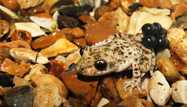
Amphibian Taxon Advisory Group Best Practice Guidelines for Midwife toads (Alytes sp.)
2015 -Wells, E., Garcia-Alonso, D, Rosa, G.M., Garcia, G. and B. Tapley.
The information contained in these EAZA Best Practice Guidelines has been obtained from numerous sources believed to be reliable. EAZA and the EAZA Amphibian TAG make a diligent effort to provide a complete and accurate representation of the data in its reports, publications, and services. However, EAZA does not guarantee the accuracy, adequacy, or completeness of any information. EAZA disclaims all liability for errors or omissions that may exist and shall not be liable for any incidental, consequential, or other damages (whether resulting from negligence or otherwise) including, without limitation, exemplary damages or lost profits arising out of or in connection with the use of this publication.
Amphibian-Taxon-Advisory-Group-Best-Practice-Guide.pdf

Amphibians and conservation breeding programmes: do all threatened amphibians belong on the ark? Biodiversity and conservation, 24: 2625-2646.
2015 -Tapley, B., Bradfield, K.S., Michaels, C. and M. Bungard.
Amphibians are facing an extinction crisis, and conservation breeding programmes are a tool used to prevent imminent species extinctions. Compared to mammals and birds, amphibians are considered ideal candidates for these programmes due to their small body size and low space requirements, high fecundity, applicability of reproductive technologies, short generation time, lack of parental care, hard wired behaviour, low maintenance requirements, relative cost effectiveness of such programmes, the success of several amphibian conservation breeding programmes and because captive husbandry capacity exists. Superficially, these reasons appear sound and conservation breeding has improved the conservation status of several amphibian species, however it is impossible to make generalisations about the biology or geo-political context of an entire class. Many threatened amphibian species fail to meet criteria that are commonly cited as reasons why amphibians are suitable for conservation breeding programmes. There are also limitations associated with maintaining populations of amphibians in the zoo and private sectors, and these could potentially undermine the success of conservation breeding programmes and reintroductions. We recommend that species that have been assessed as high priorities for ex situ conservation action are subsequently individually reassessed to determine their suitability for inclusion in conservation breeding programmes. The limitations and risks of maintaining ex situ populations of amphibians need to be considered from the outset and, where possible, mitigated. This should improve programme success rates and ensure that the limited funds dedicated to ex situ amphibian conservation are allocated to projects which have the greatest chance of success.
Amphibians-and-conservation-breeding-programmes-d.pdf
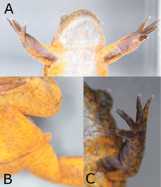
Breeding and rearing the Critically Endangered Lake Oku Clawed Frog (Xenopuslongipes Loumont and Kobel 1991). Amphibian & Reptile Conservation, 9: 100-110.
2015 -Michaels, C.J., Tapley, B., Harding, L., Bryant, Z., Grant, S., Sunter, G., Gill, I., Nyingchia, O. and T. Doherty-Bone.
The Lake Oku Clawed Frog Xenopuslongipes is a Critically Endangered, dodecaploid anuran endemic to Lake Oku in Cameroon. An ex situ population of this species was established at Zoological Society of London (ZSL), London Zoo in 2008, as well as at several other institutions, with the intention of providing data on the biology and husbandry of this species. We report the first captive breeding of the species. Adult frogs maintained under environmental conditions designed to mimic field data produced clutches of 7–300 eggs; eggs measured 1.23 mm in diameter, and were laid singly after a period of 6.5 hours in axial amplexus. Spawning took place only during the day. Tadpoles hatched in 2–3 days and development was very long compared to congeners, lasting 193–240+ days until metamorphosis. Tadpoles grew very large (maximum 79 mm total length), particularly compared with the relatively small adult size (maximum 36 mm Snout to Vent Length [SVL]). Tadpoles proved to be highly sensitive to total dissolved solids (TDS) in the water and only thrived when low levels (20 mg/L) were used. Metamorphosis concluded with an SVL of 19–25 mm and F1 animals began first sexual activity at 5–6 months post metamorphosis. These data will inform future husbandry in captivity as well as illuminating facets of biology previously unknown and difficult to determine in the field.
Breeding-and-rearing-the-Critically-Endangered-Lak.pdf
https://www.theguardian.com/environment/radical-conservation/2015/apr/28/frog-london-zoo-amphibian-conservation-endangered
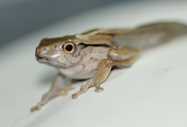
Captive husbandry and breeding of file-eared tree frogs, Polypedatesotilophus (Boulenger, 1893) (Amphibia: Anura: Rhacophoridae). Herpetological Bulletin, 132: 5-8.
2015 -Tapley. B. and S. Girgin
Six Polypedatesotilophus were reared from small juveniles to adult breeding size over a period of 18 months. An account of captive husbandry and breeding is provided. Clutch size ranged from 44 – 119 eggs. Eggs hatched after ten days and tadpoles attained total lengths of 85 mm. Metamorphosis took 74 – 84 days at 22 – 26 ˚C
Captive-husbandry-and-breeding-of-fileeared-tree.pdf
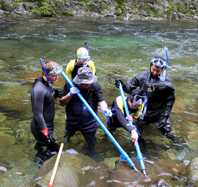
Failure to detect the Chinese giant salamander (Andriasdavidianus) in Fanjingshan National Nature Reserve, Guizhou Province, China. Salamandra, 51: 206–208.
2015 -Tapley, B., Okada, S., Redbond, J., Turvey, S.T., Chen, S., Lü, J., Wei, G., Wu, M.Y., Pan, Y., Niu, K.F. and A.A. Cunningham.
Our failure to detect A.davidianus in the Heiwan and Panxi rivers of FNNR and the presence of ongoing poaching of this protected species in a protected area highlights the need for radically improved and strengthened conservation management of A.davidianus in FNNR, and possibly elsewhere in China. We suggest that this is achieved through raising the profile of A.davidianus in communities within the range of the species and amongst tourists visiting protected areas with historical or existing A.davidianus populations, as well as through regular night-time patrols of the river systems that contain A.davidianus by protected area staff. Further visual encounter and villager surveys are required throughout the historical range of A.davidianus in order to assess the current distribution and abundance of this Critically Endangered species and the degree to which it is still threatened by illegal hunting.
Failure-to-detect-the-Chinese-giant-salamander-An.pdf
https://chinesegiantsalamanders.org/

Itraconazole treatment of Batrachochytriumdendrobatidis (Bd) infection in captive caecilians (Amphibia: Gymnophiona) and the first case of Bd in a wild neotropical caecilian. Journal of Zoo and Aquarium Research, 3: 137-140.
2015 -Rendle, M., Tapley, B., Perkins, M., Bittencourt-Silva, G., Gower, D.J. and M. Wilkinson.
Batrachochytriumdendrobatidis (Bd) is the causative agent of the disease amphibian chytridiomycosis, one of the factors driving amphibian population declines. Bd infections are treatable in at least some cases, but in the Gymnophiona has been little reported, and restricted to heat treatment in the form of increased environmental temperature. We report the successful treatment of Bd infection in the terrestrial African caecilian Geotrypetesseraphini and the prophylactic treatment of the aquatic neotropical caecilian Potomotyphluskaupii, using 30 minute immersions in a 0.01% solution of the antifungal itraconazole over a period of 11 days. Previously only recorded in wild African Gymnophiona, our report of Bd in P.kaupii is not only the first record of infection in a wild aquatic caecilian but also in a caecilian of neotropical origin. To improve our understanding of the impact of Bd on caecilians, Bd isolates should be obtained from wild caecilians in order to ascertain what lineages of Bd infect this order. In addition, more wild individuals should be subjected to Bd diagnostic surveys, including in Asia where caecilians have not yet been subject to such surveys.
Itraconazole-treatment-of-Batrachochytrium-dendrob.pdf
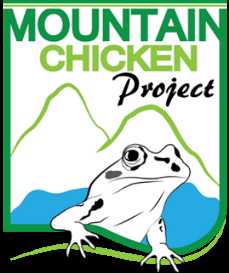
Long-Term Recovery Strategy for the Critically Endangered mountain chicken 2014-2034. Affiliation: Mountain Chicken Project.
2015 -Adams, S.L. Morton, M., Terry, A., Young, R., Dawson, J., Martin, L., Sulton, M., Hudson, M., Cunningham, A.A., Garcia, G.G., Goetz, M., Lopez, J., Tapley, B., Burton, M. and G. Gray.
The mountain chicken is a Critically Endangered frog found only on Montserrat and Dominica and is the largest native amphibian in the Lesser Antilles. Populations on both islands have been devastated by the deadly amphibian chytrid fungus, first on Dominica from 2002 and subsequently from 2009 on Montserrat. The wild population on both islands is currently estimated to be less than 100 individuals.
-LongTerm-Recovery-Strategy-for-the-Critically-E.pdf
https://www.mountainchicken.org/

Meeting ultraviolet B radiation requirements of amphibians in captivity: a case study with mountain chicken frogs (Leptodactylusfallax) and general recommendations for pre-release health screening
2015 -Tapley, B., Rendle, M., Baines, F.M., Goetz, M., Bradfield, K.S., Rood, D., Lopez, J., Garcia, G. and A. Routh
Conservation breeding programmes are a tool used to prevent amphibian extinctions. The husbandry requirements of amphibians are complex. Ongoing research is needed to ensure optimal management of those captive‐bred animals destined, in particular, for reintroduction. The UV‐B and vitamin D3 requirements of amphibians are largely unknown. Metabolic bone disease has been reported in a number of species. These include the Critically Endangered mountain chicken frog (Leptodactylusfallax) reared in captivity on diets supplemented with a high‐calcium multivitamin and mineral supplement vitamin D3 but without UV‐B provision. Captive‐bred L.fallax being reared for reintroduction to Montserrat were provided with UV‐B radiation from metamorphosis and were fed on insects supplemented with vitamins and minerals. Overlapping heat, light and UV‐B gradients were provided, mimicking what we believe best represents the natural situation and thereby facilitated self‐regulation of UV‐B exposure. A subset of 10 frogs was periodically radiographed to assess skeletal health. Radiographic bone density and anatomical integrity appeared unremarkable when compared with a wild caught L.fallax. In addition to other routine health‐screening, we recommend that radiography be performed to a structured schedule on a subset of all captive‐bred and reared amphibians to assess skeletal health and to gauge the appropriateness of captive husbandry. We demonstrate here that, through the appropriate provision of a combination of both UV‐B radiation and dietary supplementation, L.fallax can be bred and reared in captivity with healthy skeletal development.
Meeting-ultraviolet-B-radiation-requirements-of-am.pdf
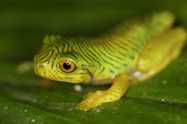
Note on range extension, local knowledge and conservation status of the Critically Endangered Anamalai gliding frog Rhacophoruspseudomalabaricus in the Cardamom Hills of Western Ghats, India. Herpetological Bulletin, 133: 1-6.
2015 -Harpalani, M., Parvathy, S., Kanagavel, A., Eluvathingal, L. M. and B. Tapley.
Rhacophoruspseudomalabaricus is a Critically Endangered, range-restricted frog found in the southern Western Ghats of India. We report new distribution records outside the protected area network in the Cardamom Hills of Kerala State through direct sightings and local ecological knowledge. These records increase the distribution by 12 km to the south-east of its currently known range and increase the altitudinal range of the species to 1600 m asl. We present a preliminary call analysis of the species that is distinct from the call of its nearest congener R.malabaricus. Foam nests, tadpoles and metamorphs were sighted in agricultural land suggesting the importance of these landscapes for breeding. Breeding continues into the month of November extending the known length of its breeding season. Breeding occurred in highly disturbed areas and oviposition sites varied according to the vegetation around breeding sites and included the use of non-native plants. This suggests the need to exercise caution while conducting habitat restoration programs that involve a standard removal of non-native plants. The IUCN Red List status for this species could be revised from ‘Critically Endangered’ to ‘Endangered’ in light of our findings. Local ecological knowledge on amphibians could provide supplementary information on distinct species with local names and those that have short periods of activity, which may not be frequently encountered during field surveys.
Note-on-range-extension-local-knowledge-and-conse.pdf
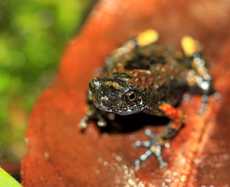
Notes on breeding and behaviour in the Anamalai Dot Frog Ramanellaanamalaiensis Rao, 1937. Herpetology Notes, 8: 221-225.
2015 -Harpalani, M., Kanagavel, A. and B. Tapley, B
Ramanellaanamalaiensis is endemic to the Anamalai Hills of the southern Western Ghats in India and is listed as “Data Deficient”. It was first described (based on a single individual) in 1937 from the base of these hills at Coimbatore, Tamil Nadu. After this, it was rediscovered in 2010 at Parambikulam Tiger Reserve, Kerala. It is known to occur in moist forests at an elevation of 100-1500 m a.s.l. and can be found on the forest floor, logs and rock crevices. In this note, we present observations on breeding and associated behaviour and sexual dimorphism of R.anamalaiensis over a period of three months from September - November 2014.
Notes-on-breeding-and-behaviour-in-the-Anamalai-Do.pdf

The tadpole of the Lake Oku clawed frog Xenopuslongipes (Anura; Pipidae). Zootaxa, 3981: 597-600.
2015 -Tapley, B., Michaels, C.J. and T.M. Doherty-Bone.
Xenopuslongipes Loumont and Kobel, 1991 is an aquatic polyploid frog endemic to the high altitude crater lake, Lake Oku in North West region, Cameroon. The tadpole of X.longipes is currently undescribed. So far, only dead tadpoles have been found at Lake Oku during regular monitoring since 2008, with specimens too decomposed to make adequate descriptions. Captive breeding provides one opportunity to obtain fresh specimens for description. A colony of X.longipes is maintained at the Zoological Society of London's (ZSL) London Zoo, as part of a conservation research programme that was developed to document the life history of this Critically Endangered species. Herein we describe the tadpole and compare it with other Xenopus tadpoles for which descriptions are available.
The-tadpole-of-the-Lake-Oku-clawed-frog-Xenopus-lo.pdf
https://www.zsl.org/zsl-london-zoo/lake-oku-clawed-frog
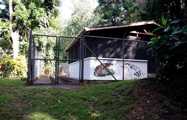
An overview of current efforts to conserve the critically endangered mountain chicken (Leptodactylusfallax) on Dominica. Herpetological Bulletin, 128: 9-11.
2014 -Tapley, B., Harding, L., Sulton, M., Durand, S., Burton, M., Spencer, J., Thomas, R., Douglas, T., Andre, J., Winston, R., George, M., Gaworek-Michalzenia, M., Hudson, M., Blackman, A. and A.A. Cunningham.
Dominica was once the stronghold of one of the giants amongst frogs: the mountain chicken (Leptodactylusfallax). L.fallax is the largest amphibian in the Caribbean region, and is currently listed as Critically Endangered by the IUCN. Currently, L.fallax is restricted to the islands of Dominica and Montserrat in the Eastern Caribbean
An-overview-of-current-efforts-to-conserve-the-cri.pdf
https://www.mountainchicken.org/

Building National Capacity in Ex-situ Amphibian Management
2014 -Gupta, B.K., Bonal, B.S., Wright, T., Routh, A., Goetz, M., Vasudevan, K. and B. Tapley
In December 20013 the Central Zoo Authority, with the assistance of Durrell Wildlife Conservation Trust and the Zoological Society ofLondon, delivered a workshop in Guwahati, Assam. The aim of the workshop was to build national capacity in amphibian management. Twenty four delegates from all over India representing 22 institutions attended the four day workshop, which highlighted the specific requirements of amphibians in the design and management of ex-situ facilities.
Building-National-Capacity-in-Exsitu-Amphibian-Ma.pdf
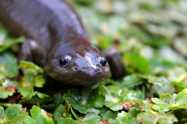
Saving salamanders; Approaches as diverse as the animals themselves. Froglog 110: 12-16
2014 -Hansen, C.M., Garcia-Moreno, J., Moore, R., Tapley, B., Waterman, C., Serrano, K.P., Apodaca, J.J. and J.P. Lewis.
As we move further into the Year of the Salamander we wanted to celebrate some of the great efforts underway around the world to help save these incredible creatures. Here we showcase a number of projects that utilize different, and sometimes innovative, approaches to addressing conservation challenges. In all the cases the success is dependent upon a collaborative effort, an approach that is the foundation of the Amphibian Survival Alliance. During the Year of the Salamander, the ASA is committed to helping highlight the plight of Salamanders around the world and through the Alliance implement action to address some of these challenges. It is hoped that when the next Year of the Salamander comes around that we will have an even longer list of salamander success stories to showcase.
Saving-salamanders-Approaches-as-diverse-as-the-a.pdf

Towards evidence-based husbandry for caecilian amphibians: Substrate preference in Geotrypetesseraphini (Amphibia: Gymnophiona: Dermophiidae). Herpetological Bulletin, 129: 15-18.
2014 -Tapley, B., Bryant, Z., Grant, S., Kother, G., Feltrer, Y., Masters, N., Strike, T., Gill, I., Wilkinson, M. and D.J. Gower.
Maintaining caecilians in captivity provides opportunities to study life-history, behaviour and reproductive biology and to investigate and to develop treatment protocols for amphibian chytridiomycosis. Few species of caecilians are maintained in captivity and little has been published on their husbandry. We present data on substrate preference in a group of eight Central African Geotrypetesseraphini (Duméril, 1859). Two substrates were trialled; coir and Megazorb (a waste product from the paper making industry). G.seraphini showed a strong preference for the Megazorb. We anticipate this finding will improve the captive management of this and perhaps also other species of fossorial caecilians, and stimulate evidence-based husbandry practices.
Towards-evidencebased-husbandry-for-caecilian-amp.pdf
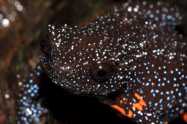
Defensive behaviour of Melanobatrachusindicus (Anura: Microhylidae) in the Western Ghats, India. Herpetology Notes 6:607-608
2013 -Kanagavel, A. and Tapey, B.
Defensive behaviour in the Endangered frog Melanobatrachusindicus is described for the first time
Defensive-behaviour-of-Melanobatrachus-indicus-An.pdf

Batrachochytriumdendrobatidis infection and lethal chytridiomycosis in caecilian amphibians Gymnophiona. EcoHealth
2012 -Gower, D.J., Doherty Bone, T, Loader, S.P., Wilkinson, M., Kouete, M., Tapley, B., Orton, F., Daniel, O.Z., Wyne, F., Flach, E., Muller, H., Menegon, M.m Stephen, I., Browne, R.K., Fisher, M.C., Cunningham, A.A. and T.W.J. Garner
Batrachochytriumdendrobatidis (Bd) is commonly termed the 'amphibian chytrid fungus' but thus far has been documented to be a pathogen of only batrachian amphibians (anurans and caudatans). It is not proven to infect the limbless, generally poorly known, and mostly soil-dwelling caecilians (Gymnophiona). We conducted the largest qPCR survey of Bd in caecilians to date, for more than 200 field-swabbed specimens from five countries in Africa and South America, representing nearly 20 species, 12 genera, and 8 families. Positive results were recovered for 58 specimens from Tanzania and Cameroon (4 families, 6 genera, 6+ species). Quantities of Bd were not exceptionally high, with genomic equivalent (GE) values of 0.052-17.339. In addition, we report the first evidence of lethal chytridiomycosis in caecilians. Mortality in captive (wild-caught, commercial pet trade) Geotrypetesseraphini was associated with GE scores similar to those we detected for field-swabbed, wild animals.
Batrachochytrium-dendrobatidis-infection-and-leth.pdf
https://phys.org/news/2013-05-fatal-fungus-major-amphibian-group.html
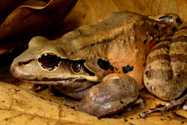
Two remarkable prey items for a chicken. Letptodactylusfallax predation upon the therapsid spider (Crytopholisfemoralis) and the colubrid snake (Liophisjuliae). Tropical Zoology
2012 -Rosa,G.M, Bradfield, K., Fernandez-Loras, A., Garcia, G. and B. Tapley
Published records of amphibians preying on either large spiders or snakes in the wild are rare; this note documents predation by individuals of one amphibian species on both large spiders and snakes. Mountain chicken frogs (Leptodactylusfallax), which are amongst the largest frogs in the world, were observed successfully consuming the theraphosid spider Cyrtopholisfemoralis on two occasions and attempting to consume another one on a further occasion on Montserrat. They were also found to have consumed the colubrid snake Liophisjuliae on Dominica. This is the first theraphosid and the fourth snake species identified in the diet of L.fallax, and this frog is the first confirmed predator of C.femoralis.
Two-remarkable-prey-items-for-a-chicken-Letptodac.pdf
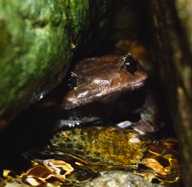
Brachytarsophrysfeae (Kakhien Hills spadefoot toad): calling site. Herpetological Bulletin 117: 38-39
2011 -Tapley, B
Observations herein were made in Tam Dao hill station in Tam Dao national park located in Vinh Phu province, northern Vietnam at 990 m asl. Between 19:30 and 22:30 six male B. feae were heard vocalising from small caves under rocky overhangs in a very shallow, slow moving, clear water stream.
Brachytarsophrys-feae-Kakhien-Hills-spadefoot-toa.pdf
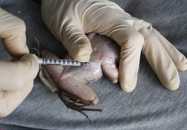
A field method for blood sampling of male anurans with hypertrophied limbs. Phyllomedusa 10: 75-77
2011 -Tapley,B., Acosta, A.R. and J. Lopez
There are large cephalic veins associated with the hypertrophied arms of Leptodactylusbolivianus. Blood was taken from the cephalic veins of three individuals with a 0.5-ml insulin syringe. The syringe was rotated and/or its angle of insertion slowly increased or decreased until blood was withdrawn. The blood smears showed no abnormalities or parasites and are archived at the veterinary department at Durrell Wildlife Conservation Trust.
A-field-method-for-blood-sampling-of-male-anurans.pdf

Dynamics of the trade in reptiles and amphibians within the United Kingdom over a ten-year period. The Herpetological Journal. 21, 27-34
2011 -Tapley, B., Griffiths, R.A. and Bride, I.
This study compared the trade in reptiles and amphibians in the United Kingdom between 1992–3 and 2004–5. In particular, the impacts of captive breeding and colour and pattern morphs on price structures were examined. The number of amphibian and reptile species in the trade more than doubled over this period, and less than a third of the species traded were common to both trading periods. More traded species were listed by CITES in 1992–3 than in 2004–5. Taking into account inflation, the study showed that the price of all groups of reptiles and amphibians recorded increased over the ten-year period, and that some snake species had done so dramatically when colour and pattern morphs were considered. The price change of chelonians was probably the result of responses to changes in various trade regulations. Price increases for amphibians seemed to represent their increased popularity, coupled with the overhead costs of captive breeding on a commercial scale being transferred to the hobbyist. The increased popularity of captive-bred colour and pattern morphs could alleviate pressure on wild stocks. On the other hand, as such animals are predominantly being produced outside their countries of origin, no benefits accrue to local people and trade could undermine sustainable use programmes for wild animals.
Dynamics-of-the-trade-in-reptiles-and-amphibians-w.pdf

Fighting behaviour in the Bicoloured frog Clinotarsus (Rana) curtipes Jerdon, 1854. Herpetology Notes 4: 353-355
2011 -Tapley, B. and C.B. Purushotham.
We observed and provide a description of an aggressive interaction between two male C.curtipes at the edge of a permanent spring which is a known C.curtipes breeding site.
Fighting-behaviour-in-the-Bicoloured-frog-Clinotar.pdf
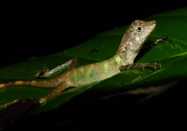
Herpetofaunal records from Pulau Bangkaru, Sumatra. Herpetology Notes 4: 413-417
2011 -Tapley,B. and M. Muurmans
The first report of reptile and amphibian species from Pulau Bangkaru, Sumatra is presented. 23 species were recorded, one species of Dicroglossidae, one species of Ranidae, one species of Rhacophoridae, four species of Gekkonidae, four species of Agamidae, one species of Scincidae, one species of Varanidae, three species of Colubridae, one species of Natricidae, one species of Lamprophiidae, one species of Crocodylidae, one species of Dermochelyidae, two species of Cheloniidae, and one species of Trionychidae.
Herpetofaunal-records-from-Pulau-Bangkaru-Sumatra.pdf
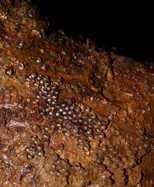
Natural history note; Indiranasemipalmata (brown leaping frog). Reptoduction. Herpetological review 42,87-88
2011 -Tapley, B., Purushotham, C.B. and Girgin, S.M
In each of the cases the eggs were hydrated when water was splashed upon them, when it dripped from the leaves or roof tiles above or ran down the branch upon which the eggs were laid. As far as we are aware, this is the first known case where tadpoles have been observed feeding on a bark substrate and subsequently metamorphosing on the bark of a tree. Given that there is such high rainfall in Agumbe, an adaptation where eggs are able to develop out of water may be a localized phenomenon. To determine if this is a viable life history strategy elsewhere would require further study in the Western Ghats.
Natural-history-note-Indirana-semipalmata-brown.pdf
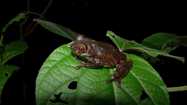
The Global Amphibian BioBlitz, find every one. FrogLog. 97:48-50.
2011 -Loarie, S.R., Kahn, T.R., Gratwicke, B., Johnson, K., Koo, M., Chaves Portilla, G.A., Tapley, B. and K. Ueda.
Amphibians are amazing! The diversity of their shapes, sizes, colours and behaviours are absolutely extraordinary! The Global Amphibian BioBlitz (GAB) not only showcases that diversity, but more importantly it helps researchers, conservationists and concerned global citizens share information and move forward actions that conserve these incredible amphibians around the world. A project ran by iNaturalist and supported by the ASG, ASA, AmphibiaWeb, AArk and the Smithsonian Conservation Biology Institute
The-Global-Amphibian-BioBlitz-find-every-one-Fro.pdf
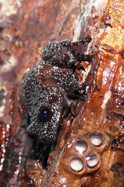
Aspects of captive husbandry of Taylors Bug-eyed Frog, Thelodermastellatum.The Herpetological Bulletin. 108, 31-33
2009 -Tapley, B
The husbandry, breeding and rearing of Thelodermastellatum is described in detail for the first time.
Bulletin-108-Tapley.pdf
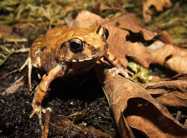
Notes on the captive husbandry and breeding of the Shovel-footed Squeaker, Arthroleptisstenodactylus.The Herpetological Bulletin. 110, 38-41
2009 -Tapley, B
The captive husbandry, breeding and rearing of the captive husbandry and breeding of the shovel-footed squeaker, a direct developing frog, is described for the first time.
Bulletin-110-Tapley-Revised-Edit.pdf
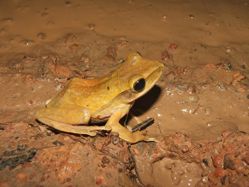
Bamboo tree frog (Polypedatesleucomystax) - EAZA husbandry guidelines.
2008 -Tapley, B
Husbandry guidelines for Polypedatesleucomystax
Polypedates-leucomystax-husbandry.pdf

Mission golden-eyed treefrog (Trachycephalusresinifictrix) - EAZA husbandry guidelines.
2008 -Tapley, B., Bradfield, K.S.
Husbandry guidelines for Trachycephalusresinifictrix.
Trachycephalus-resinifictrix-husbandry.pdf
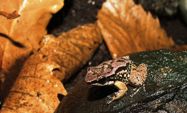
Trinidad stream frog (Mannophrynetrinitatis) - EAZA husbandry guidelines.
2008 -Tapley, B
Husbandry guidelines for Mannophrynetrinitatis.
Mannophryne-trinitatis-husbandry.pdf
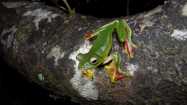
Amphibian Checklist Agumbe Rainforest Research Station Frog Leg 16:2-14
Purushotham, C.B. and B. Tapley.
We provide a checklist for amphibians encountered in and around the Agumbe Rainforest Research Station in Karnataka.
Amphibian-Checklist-Agumbe-Rainforest-Research-Sta.pdf
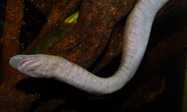
Distribution of Typhlonectesnatans in Colombia, environmental parameters and implications for captive husbandry. The Herpetological Bulletin. 113, 23-29.
Tapley, B., Acosta, A
The distribution, ecology and habitat requirements of most caecilians are unknown. We reviewed the distribution of the typhlonectid caecilian Typhlonectesnatans in Colombia using published reports and our own collecting experience. T.natans is more widely distributed than previously reported. This caecilian is the most commonly kept in captivity. Published reports regarding the captive requirements of the species are conflicting. We recorded the environmental parameters in habitats where Typhlonectesnatans was found to allow for an improved captive management of the species. Without exception this species was found associated with flowing water. It is apparent that this species disperses into floodplains during the rainy season.
Bulletin_113_TapleyAcosa_Typhlonectes.pdf
 frogshot.co.uk
frogshot.co.uk